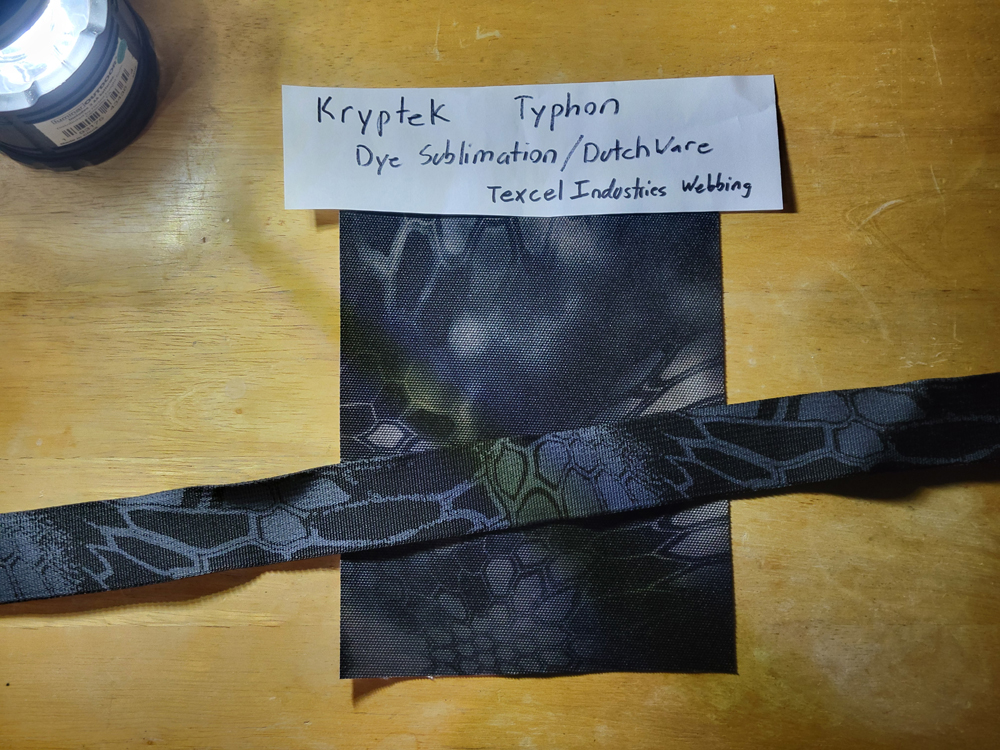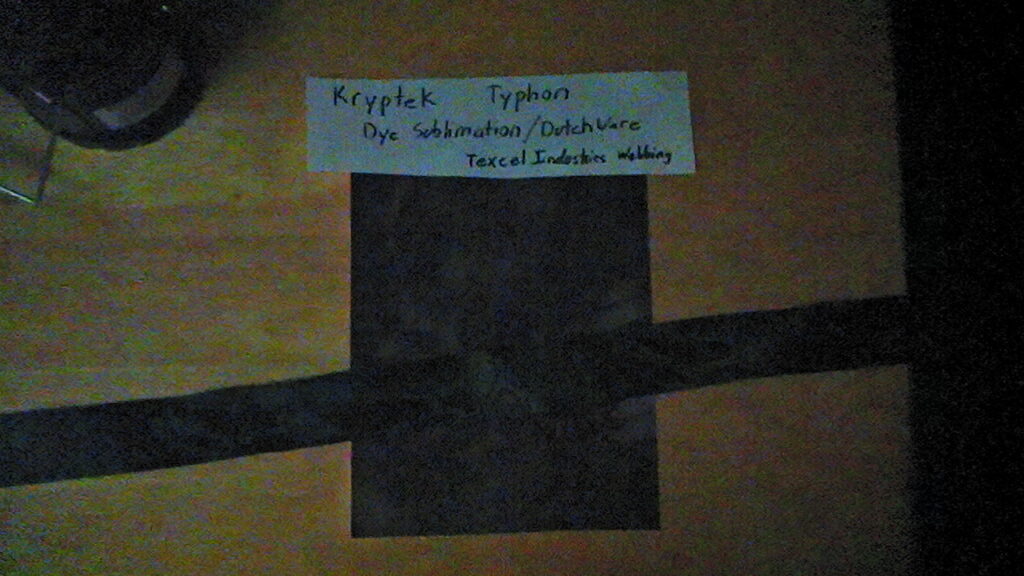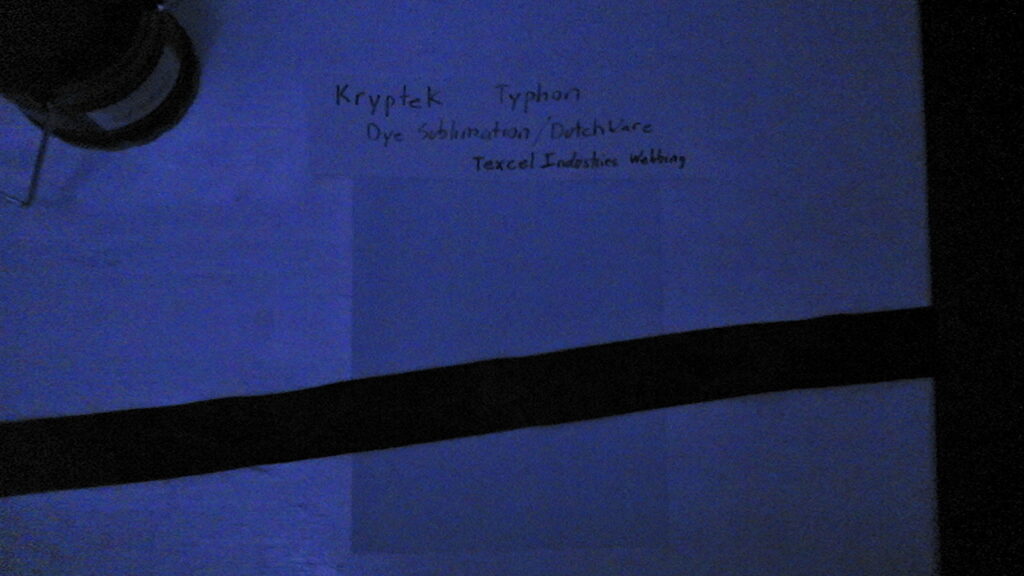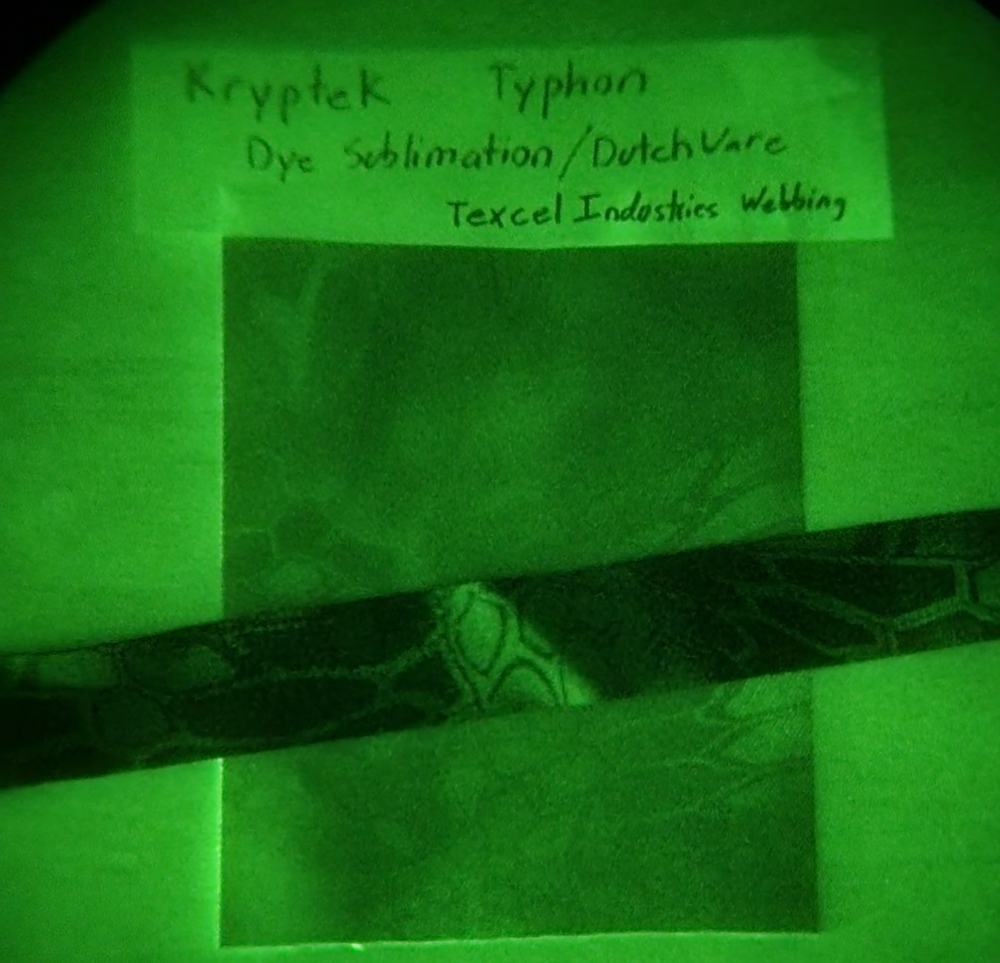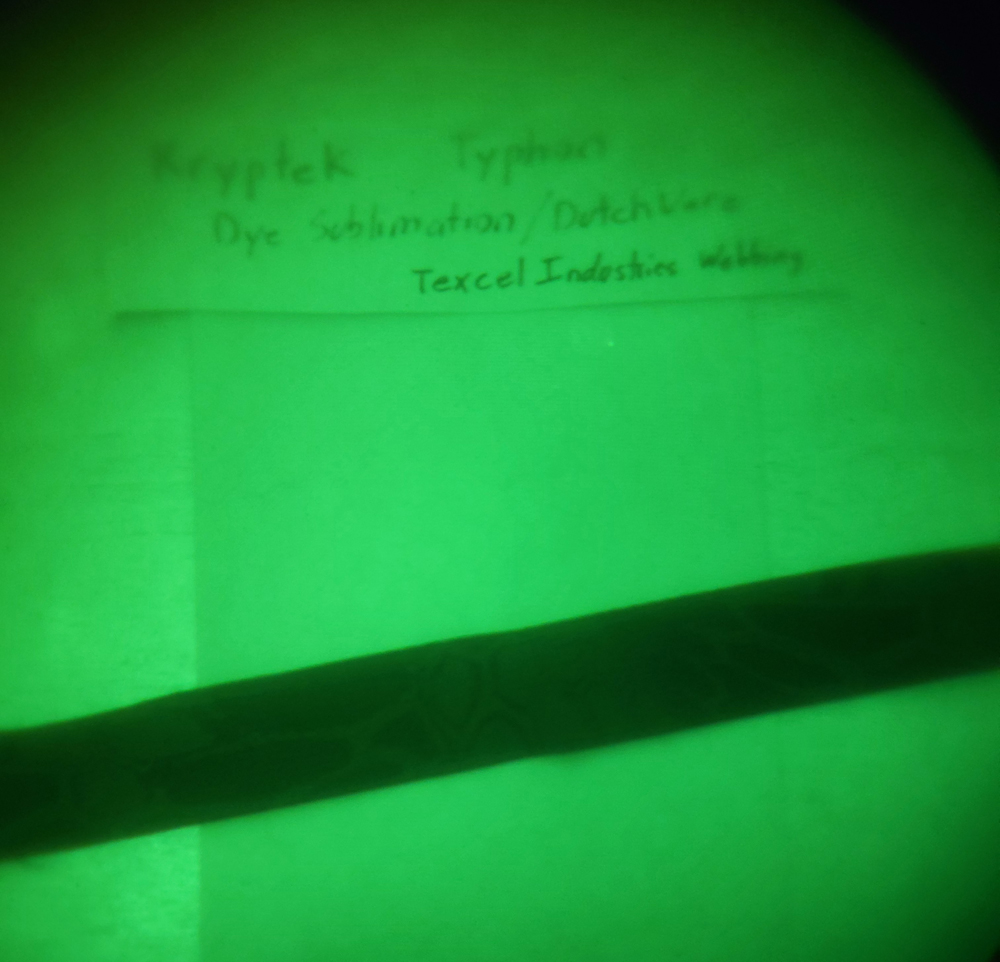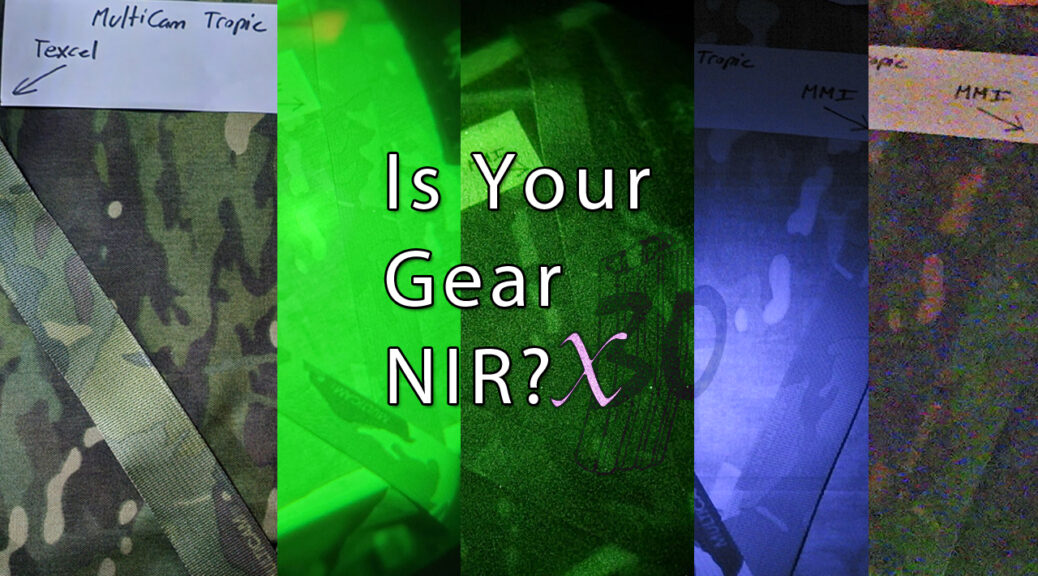NiR (Near Infrared or Near Infrared Reduced) is a designation given to compliant military soft goods or hardware whose camoflauge pattern is not negated by viewing that item in the infrared spectrum. In a nutshell… Does your uniform stand out when observed under night vision where it is hidden when observed under visible (white) light? Originally I was making individual posts on the subject regarding each individual camo pattern that I encountered and was able to test. I decided to instead compile all of the findings on one page, here.
Yes, I did test DogeCam (otherwise known as MultiDoge). As it is not serious I am keeping it off of this master list. But due to the high request volume I will link it here.
How are the tests conducted.
Currently I have Gen3 analogue night vision and digital night vision in the form of a Sionyx Aurora Black camera.
- First, I will always take a “white light” image first which is taken in a dark room with a small lantern shining white light onto the camouflage pattern.
- Second, I will take digital night vision shot without infrared help. If the environment is too dark for the digital nod to resolve an image I will help it out with a little bit of white light. Remember we aren’t comparing digital vs analogue night vision here. We are testing the effectiveness of the fabric and camo pattern when reflecting Infrared (IR) light.
- Third, I will use an IR illuminator to shine directly on the fabric.
- Fourth, I will switch to analogue gen3 night vision to take an photo with NO IR illumination.
- Fifth, I will use an IR illuminator to take a last photo with gen3 analogue.
What do the results mean?
What we are trying to figure out is, does your fabric and pattern of choice maintain the visual characteristics under IR illumination that it normally does under white light? Many conduct this experiment incorrectly by simply turning on their night vision goggles and viewing the fabric/uniform/etc. If they can still see the camo pattern they mark it down as good. This test is quite useless and assumes that NODs can ONLY see in the infrared spectrum. Your night vision device in this case is amplifying the available visible (white) light. But the enemy doesn’t illuminate you with white light if they have NODs too. They will be using infrared illumination. So, to conduct this test you need to view your fabric through your NOD with infrared light illuminating it. If a fabric is NIR then you will still see the camo pattern and it won’t “shine” back at you. Some camo patterns, when illuminated on a non-NIR fabric, will full disappear only leaving what looks like a white sheet of fabric. No good for hiding.
Results are listed alphabetically by the specific patterns name. For instance “Crye Precision MultiCam” will be sorted under M for “MultiCam” not C for “Crye”.
If you need info on where to buy these materials check out the 30MC list of Materials and Sources.
A-TACS FG
1000 Denier CORDURA. Official licensed material.
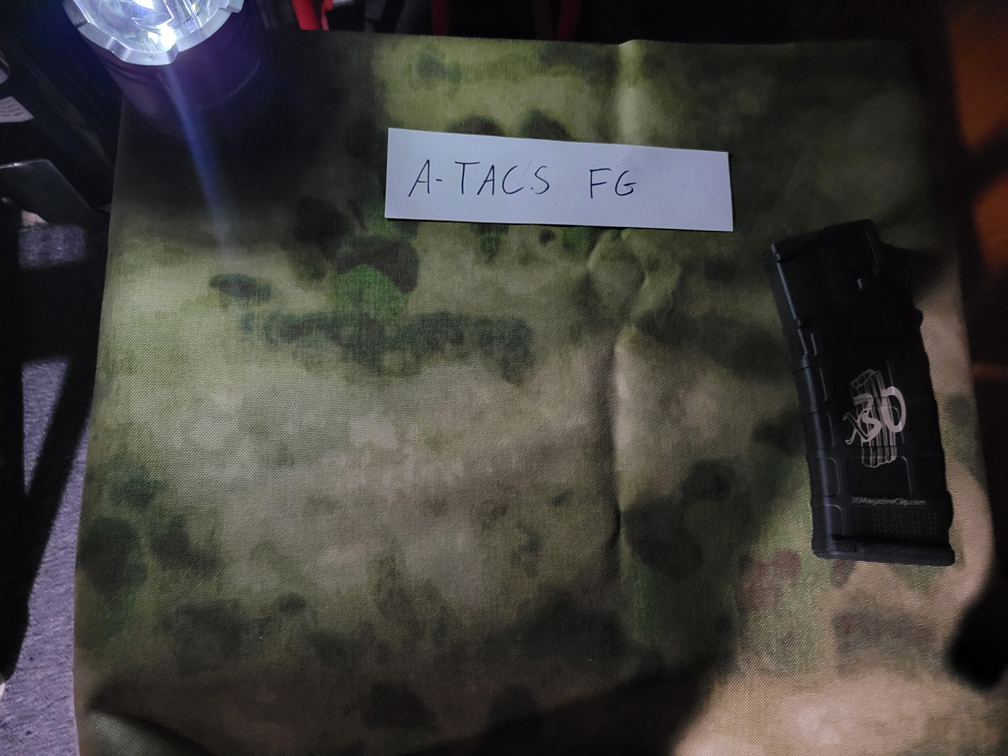
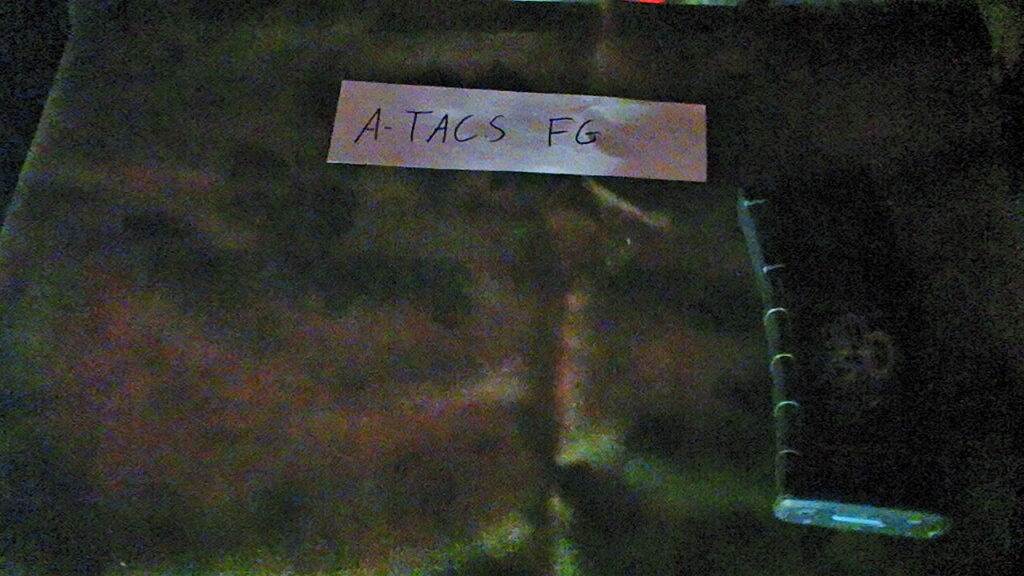
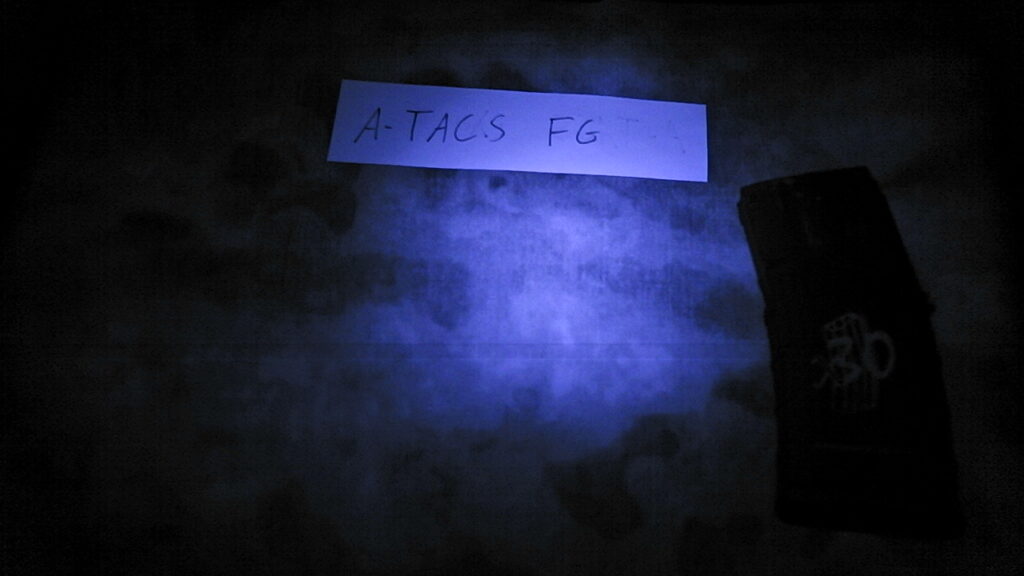
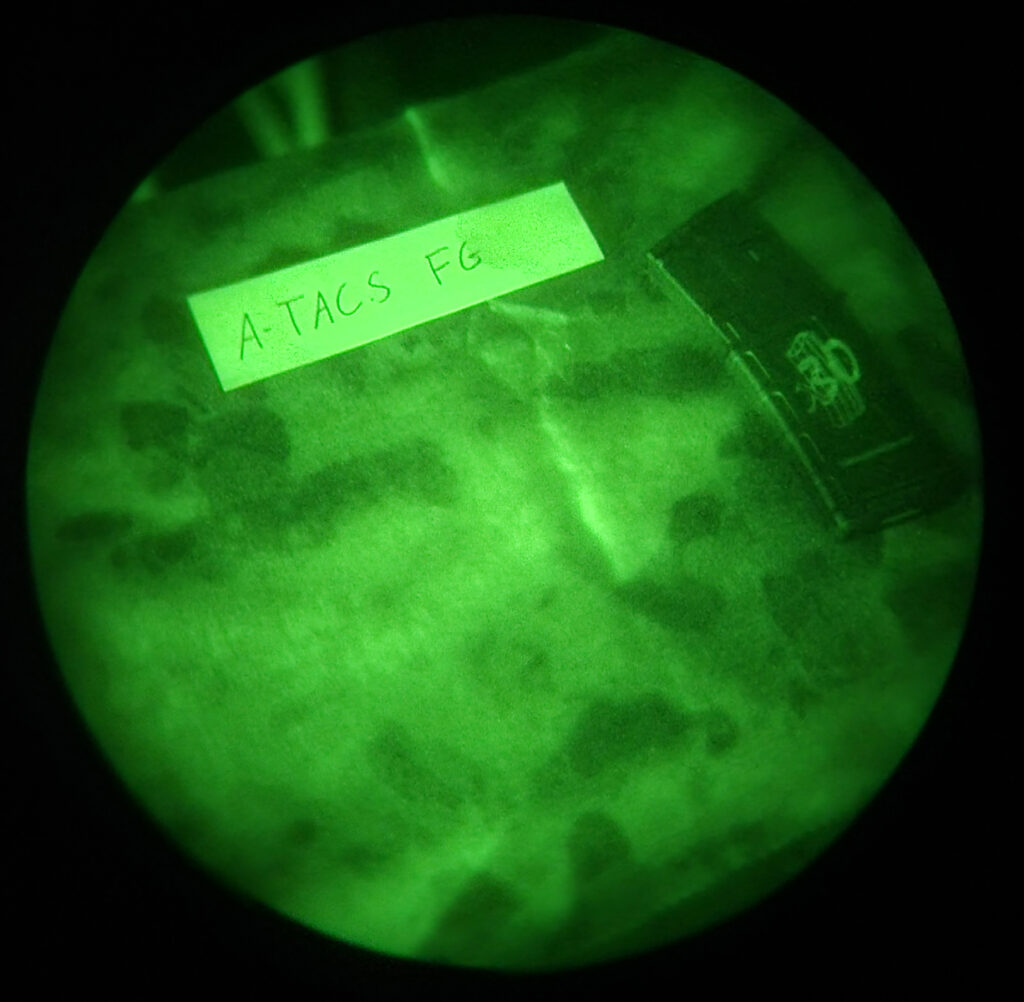
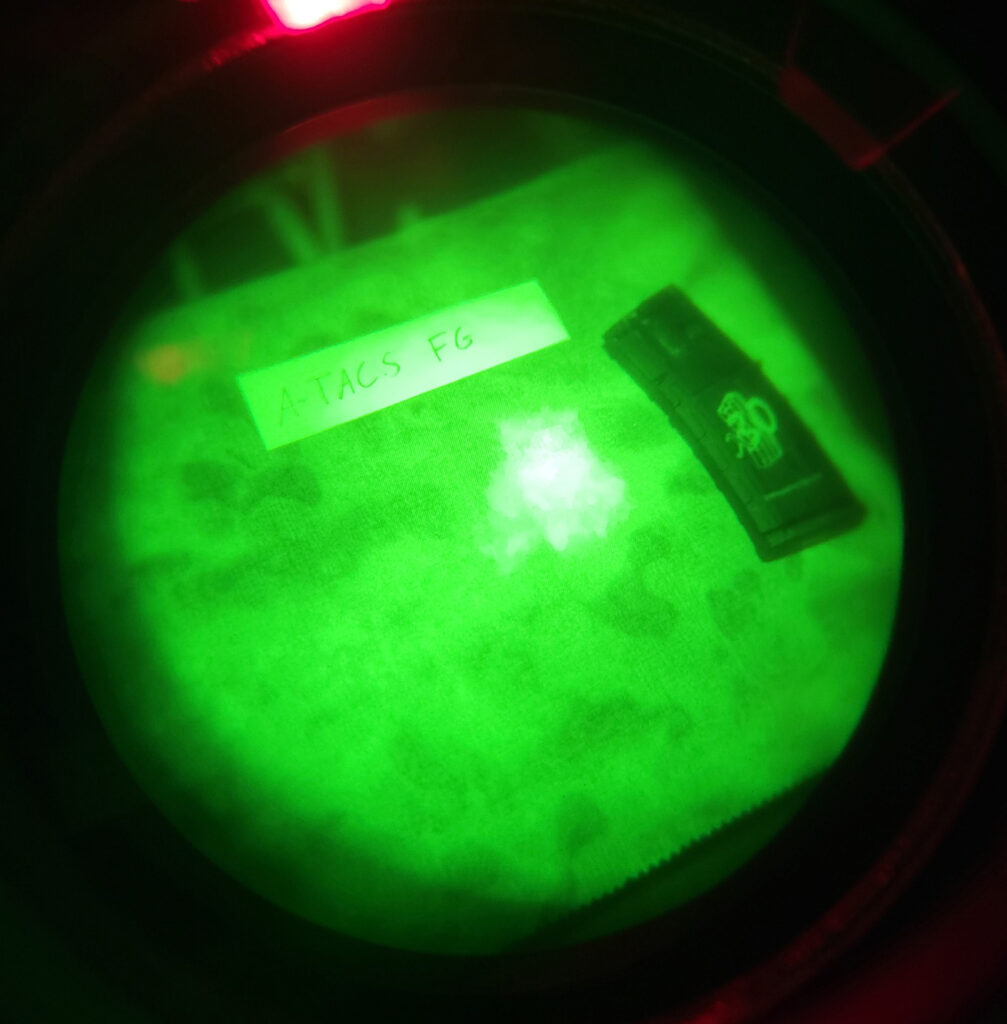
A-TACS iX
1000 Denier CORDRUA. Official licensed material.
iX did a great job under normal Gen3 Night Vision and also pretty great with IR. The visual signature remained true.

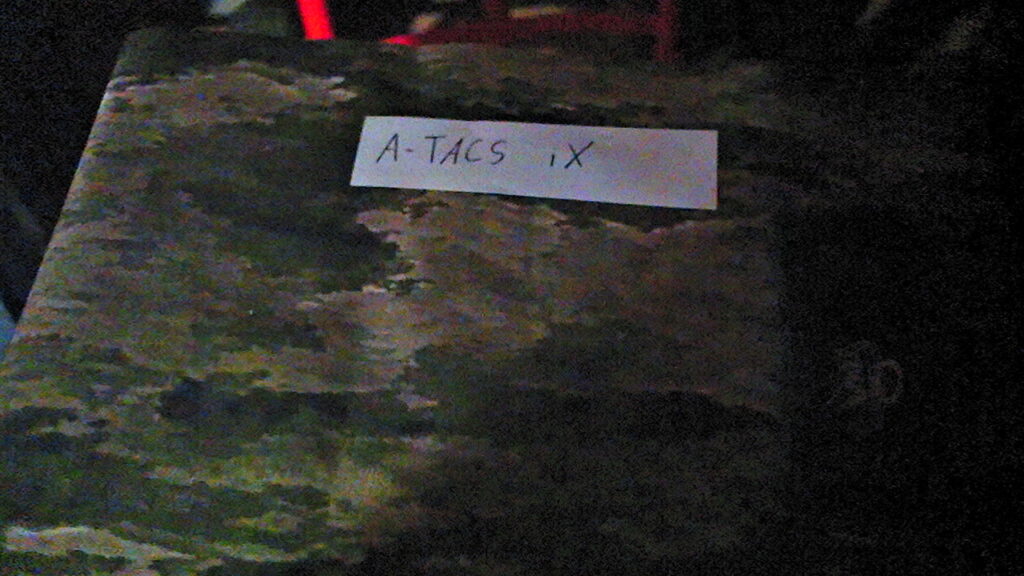
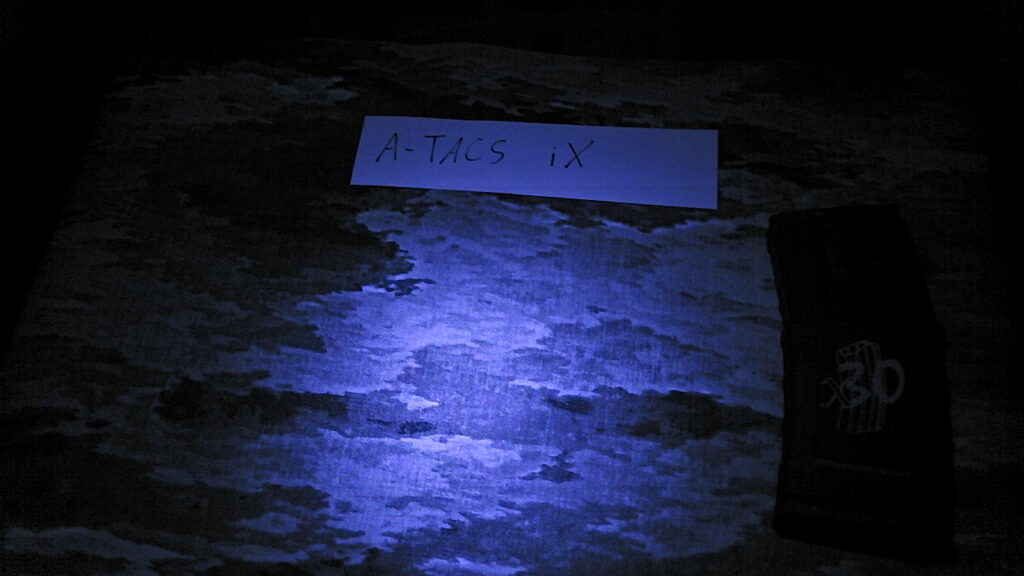
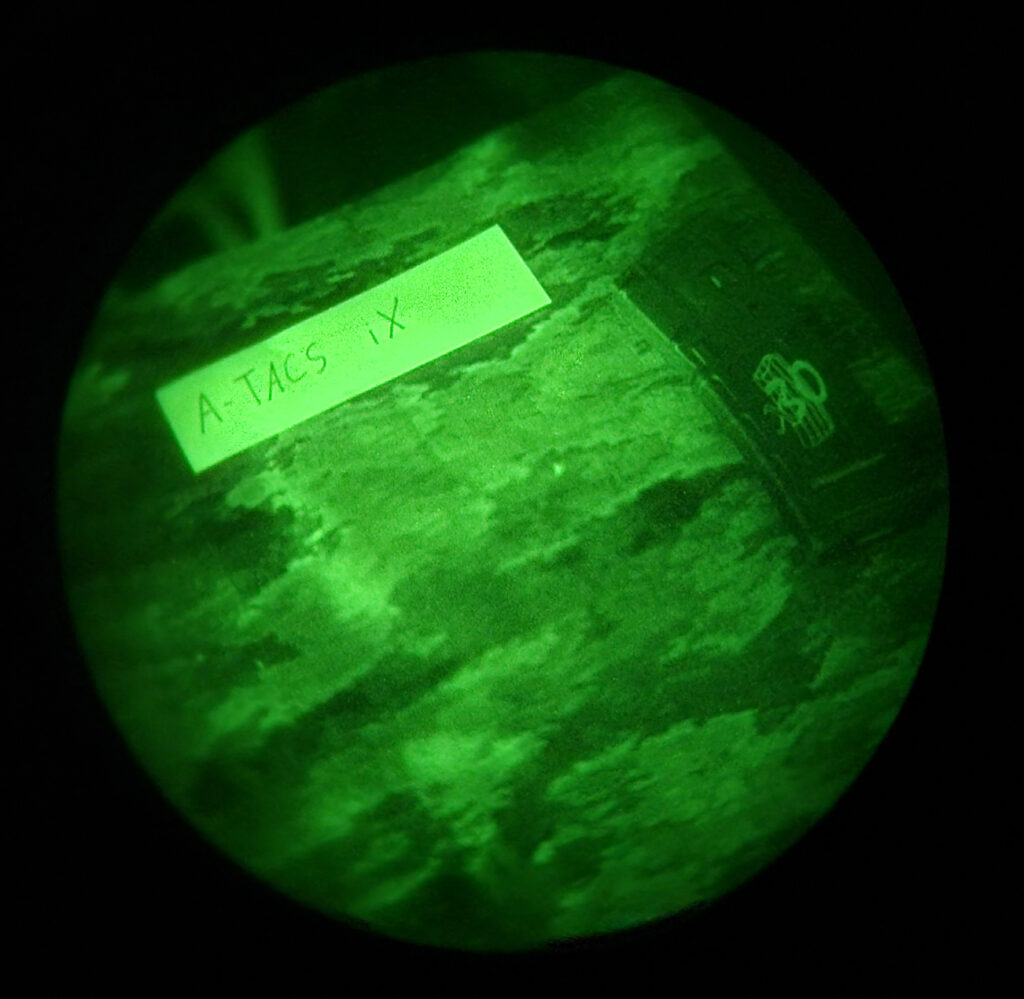
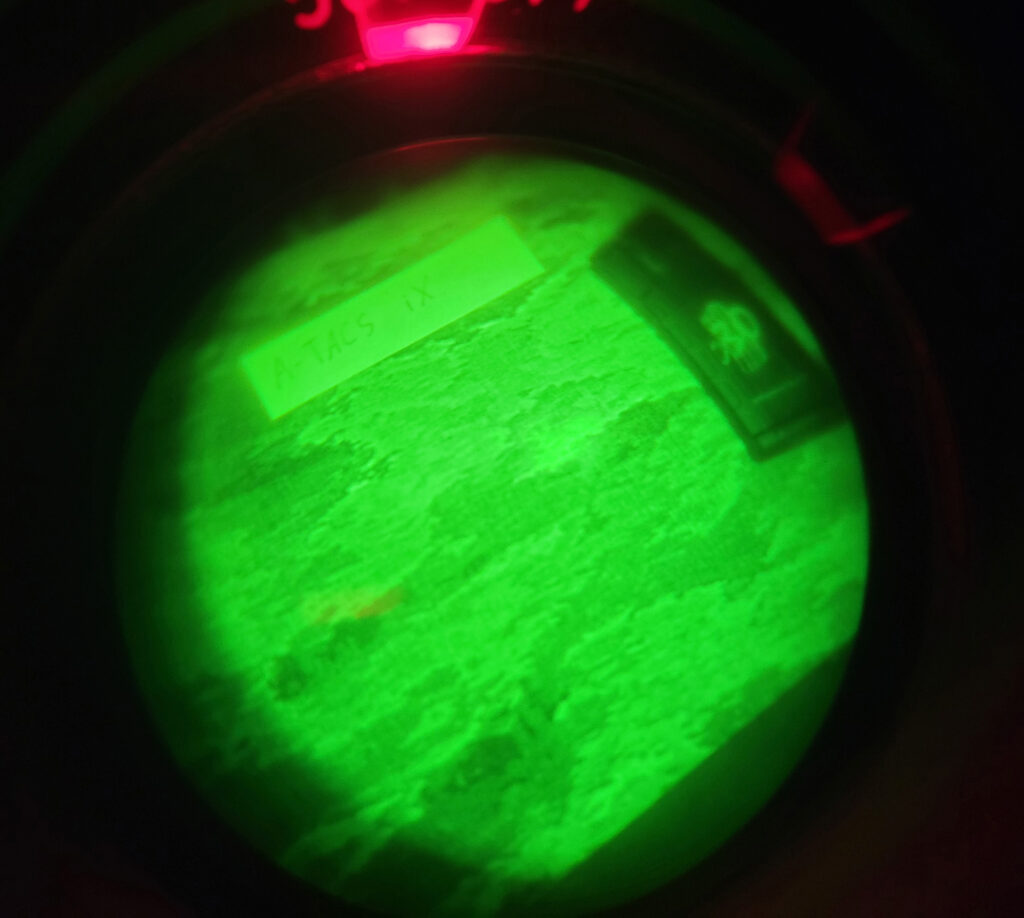
Pencott Badlands
500 Denier CORDURA fabric. Licensed material. Purchased from Rockywoods.
The gen3 Night Vision w/IR washed the pattern out a bit but remember this test is conducted with the IR light source only a yard away from the fabric. Pretty good results.
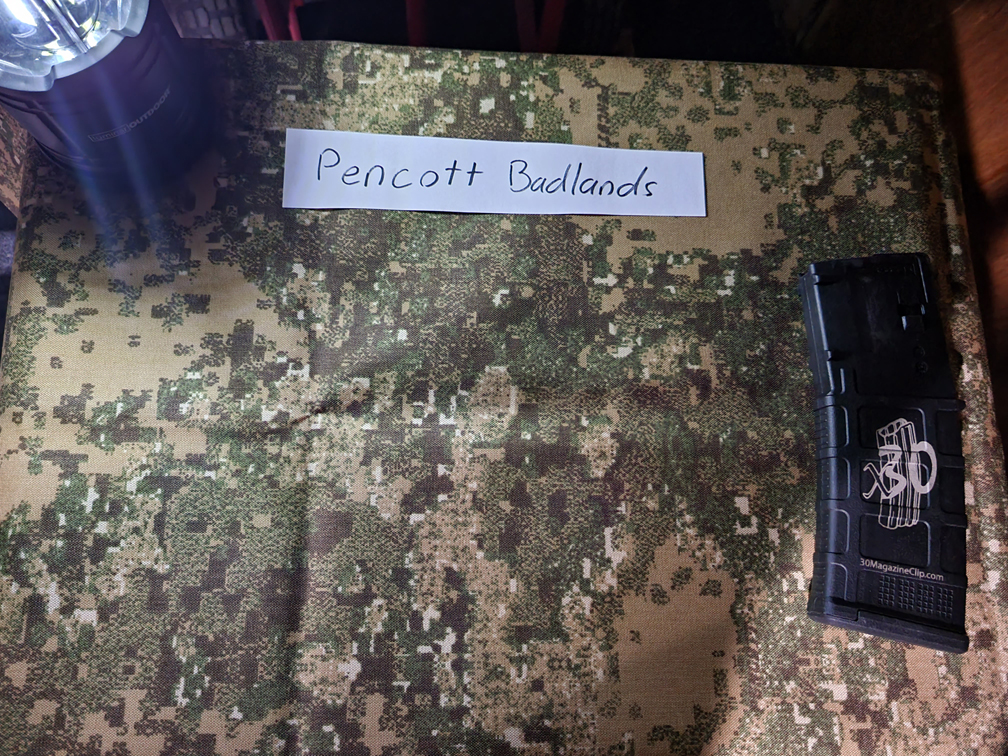
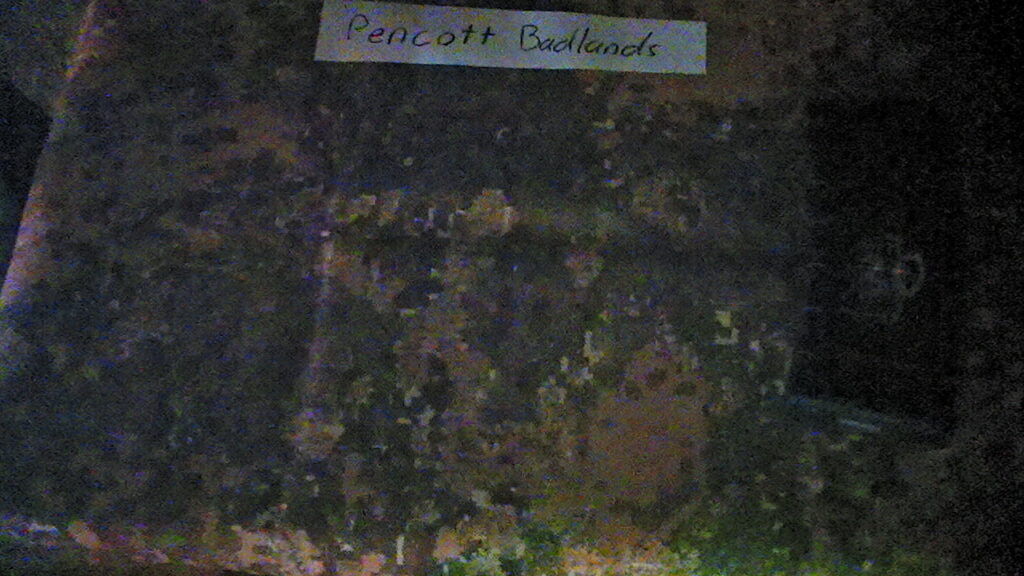
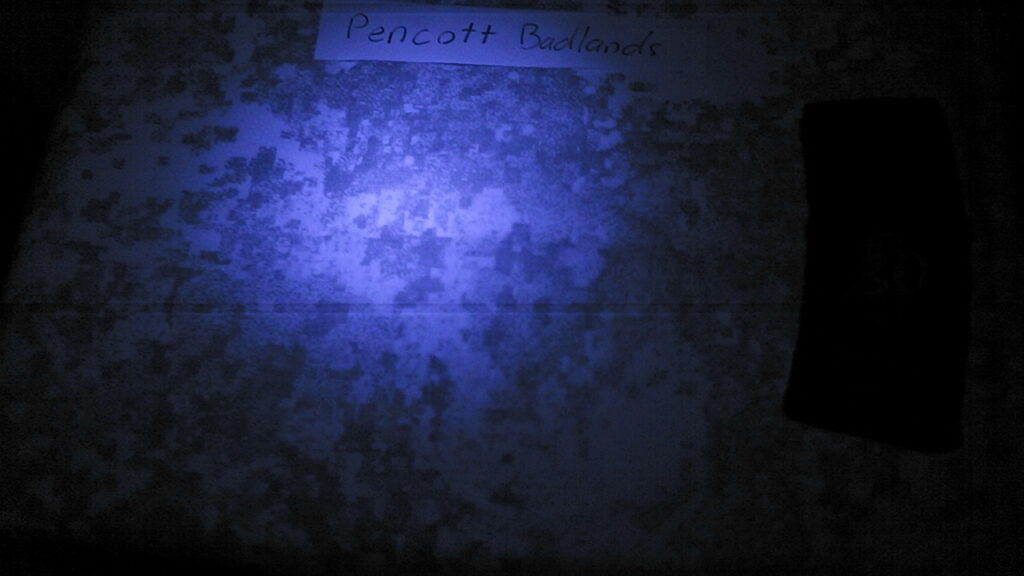
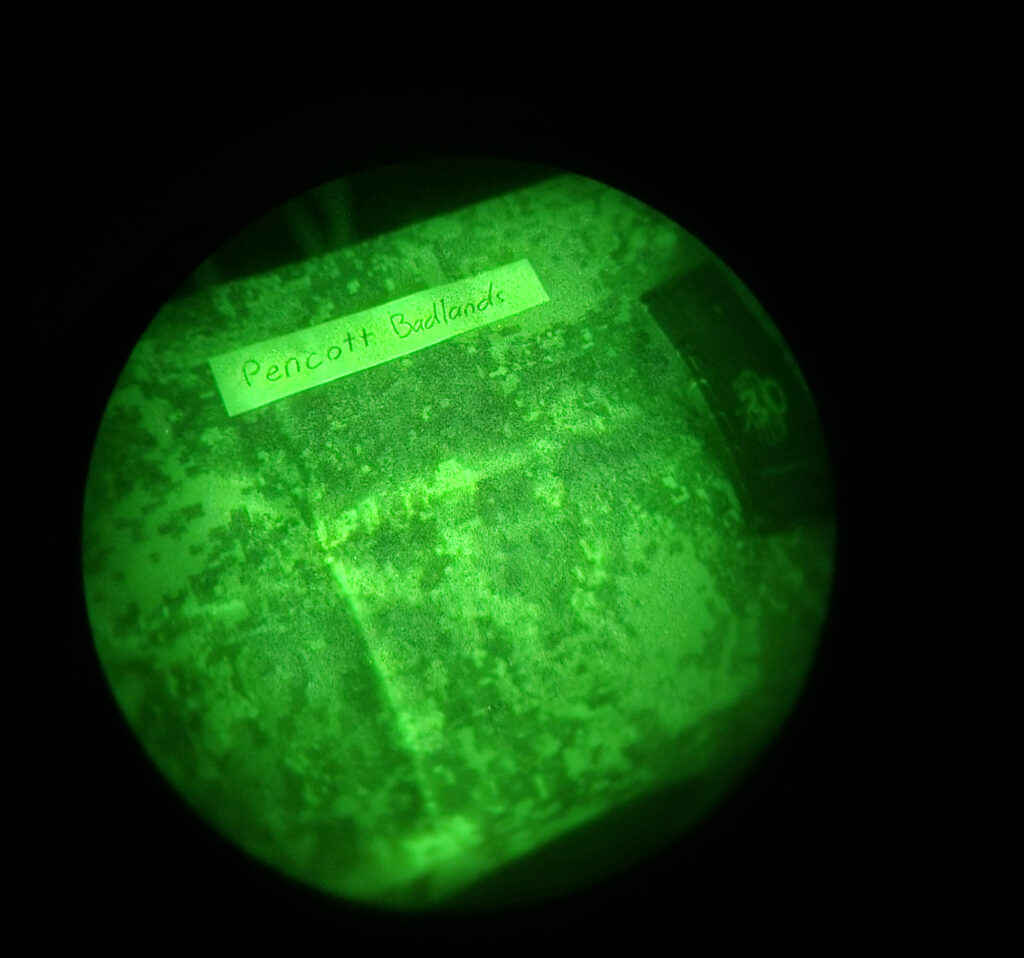
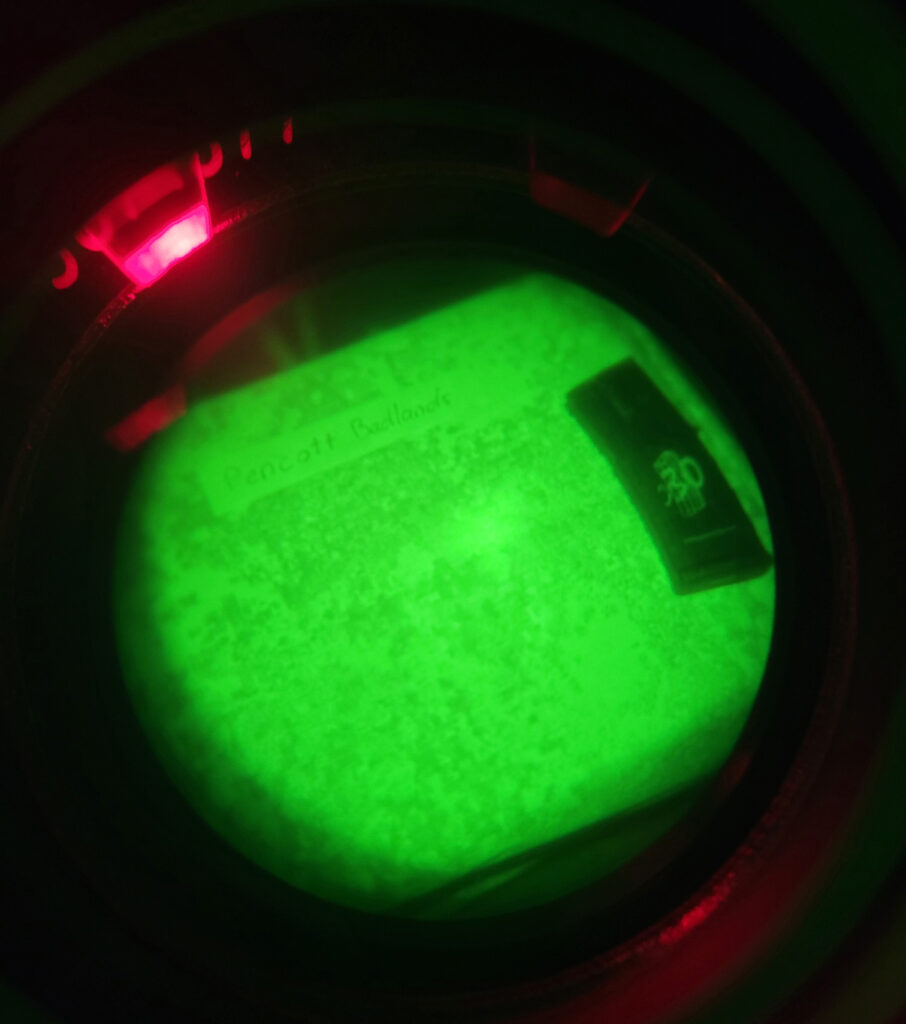
Flecktarn
1110 Denier CORDURA. Printed in Germany. Obtained from MOSTactical.com
You will notice that the camouflage pattern is quite visible between white light, green phosphor night vision and then IR illuminated night vision. Sorry, no digital night vision in this specific test.
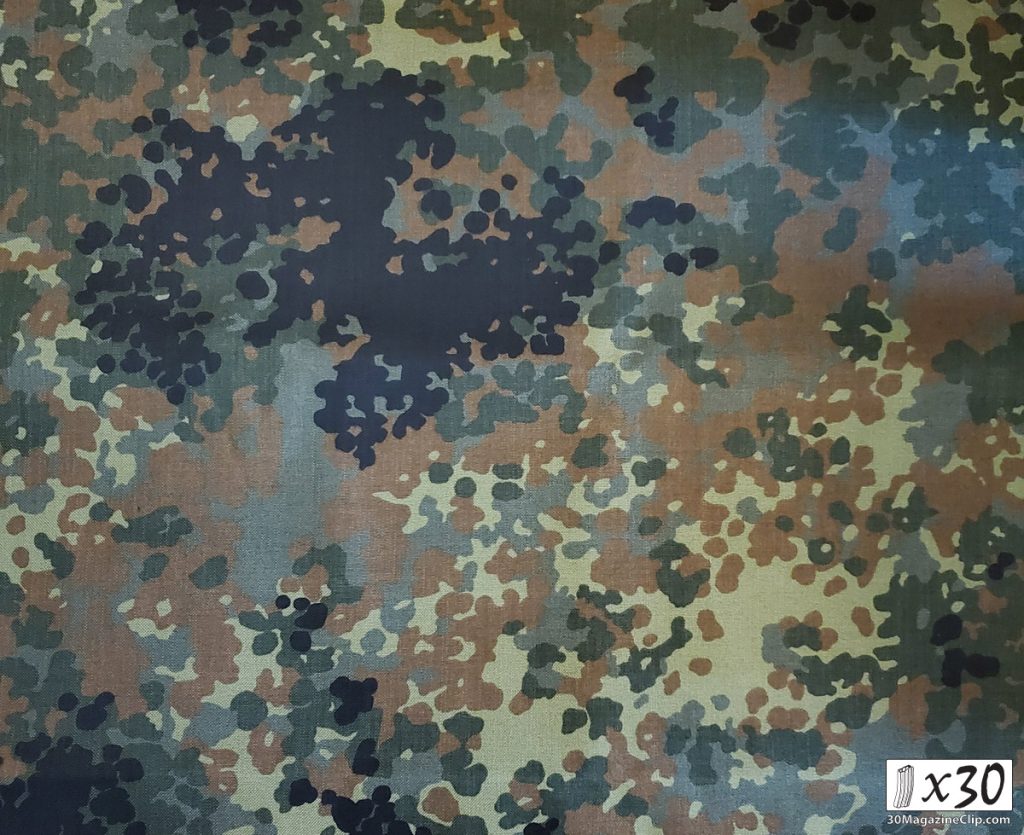

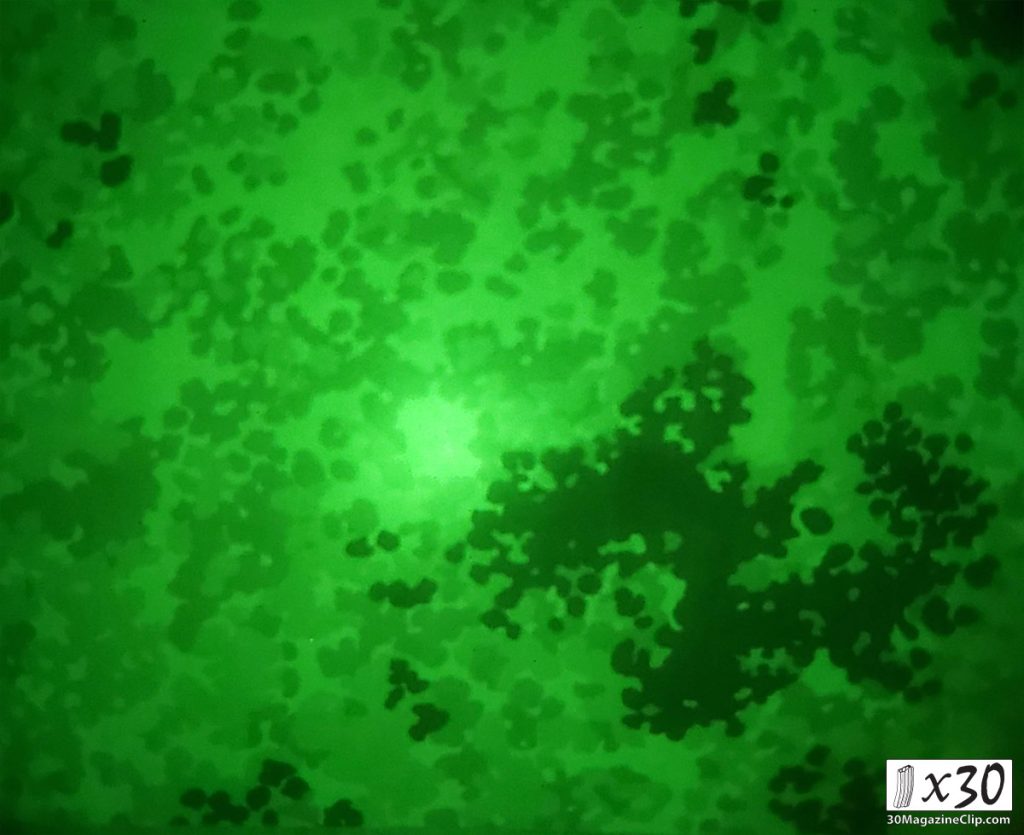
Crye Precision MultiCam
500 Denier CORDURA fabric purchased from Brookwood Roll Goods.
Webbing MIL-W-17337 from Texcel Industries.
All officially licensed materials.
Very good results when viewing with IR illumination. The fabric and webbing both maintain their pattern almost perfectly. Sorry about the blur. The webbing and fabric almost appear as the same material when hit with the IR. These are great results. But, what would you expect from one of the most (if not the most) successful camo patterns ever created?
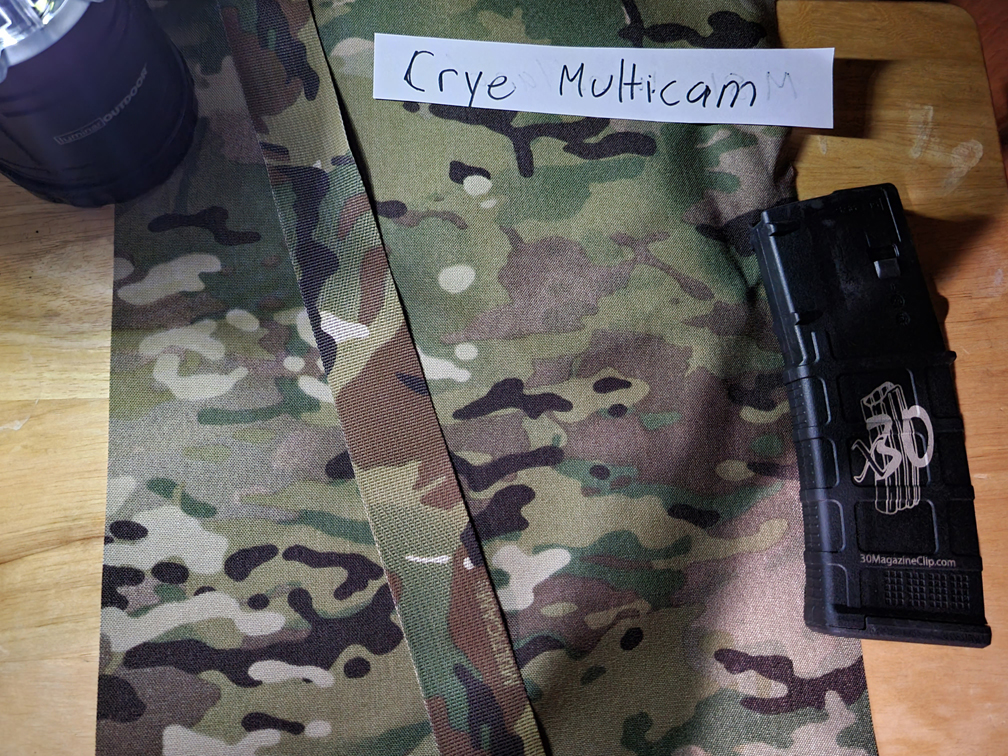
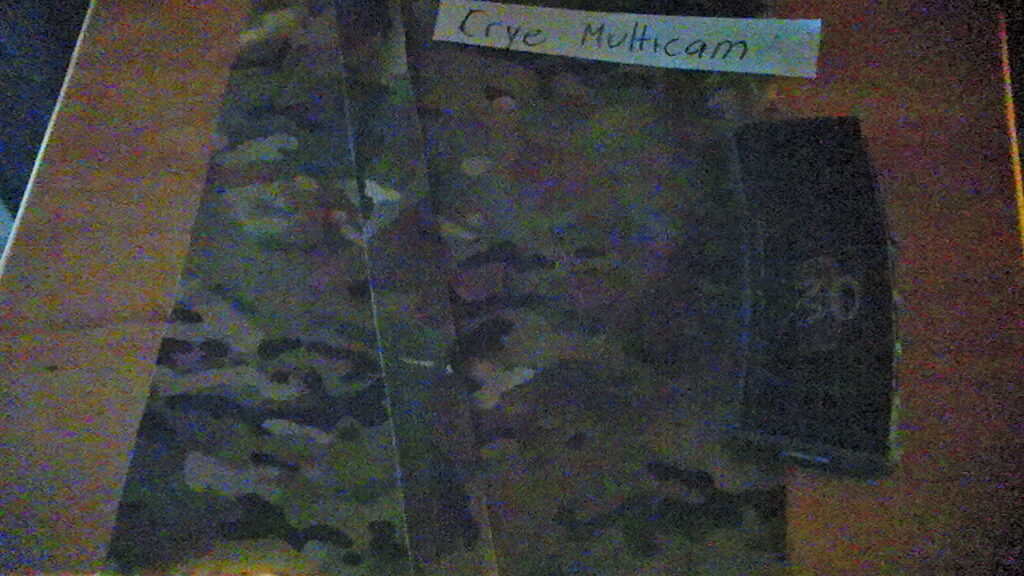
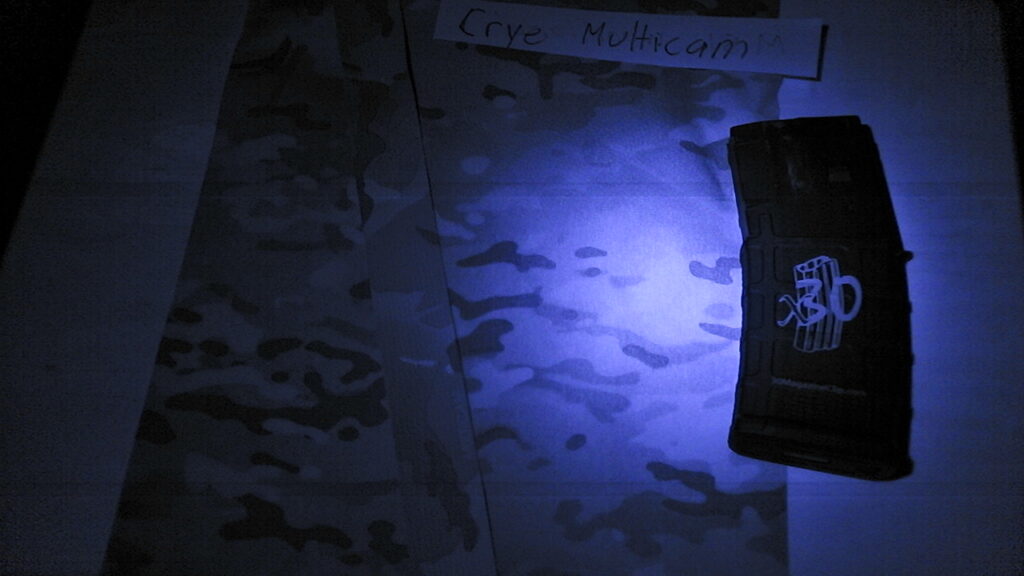
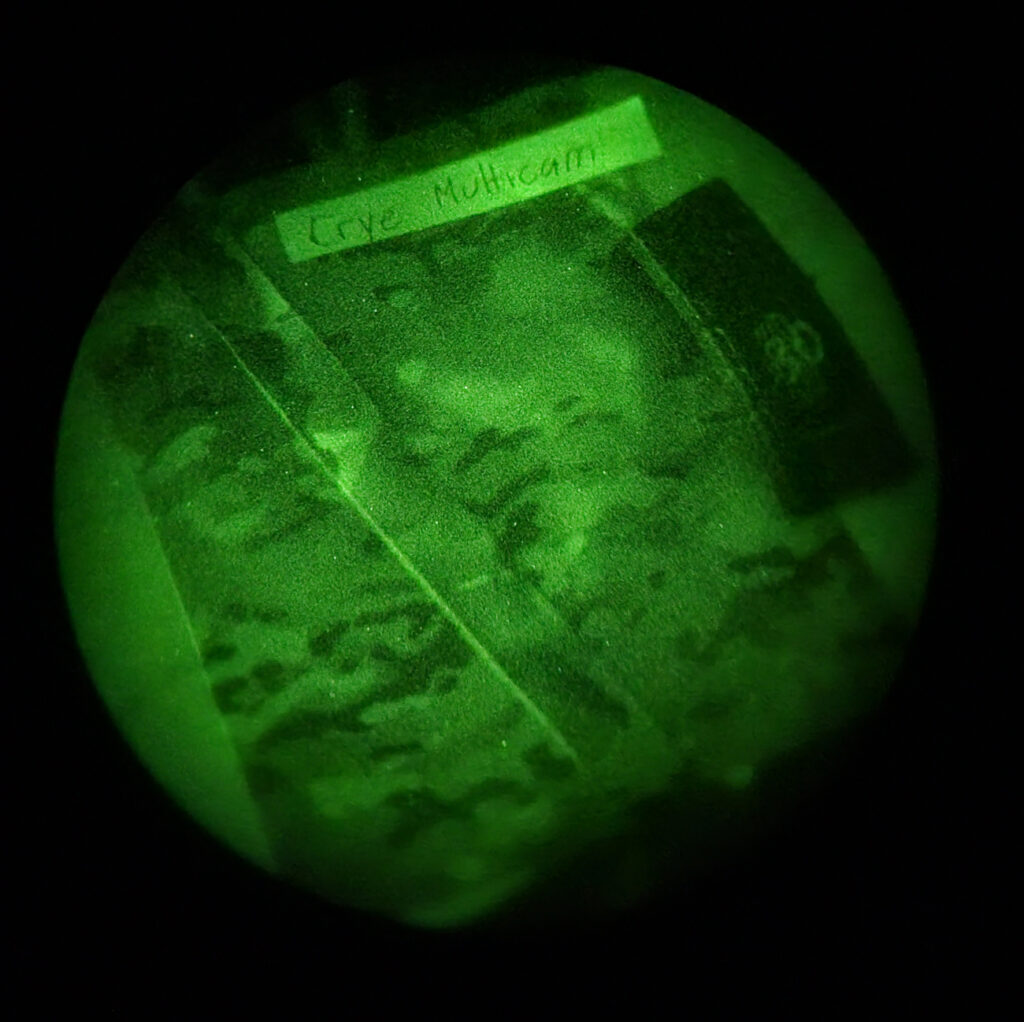
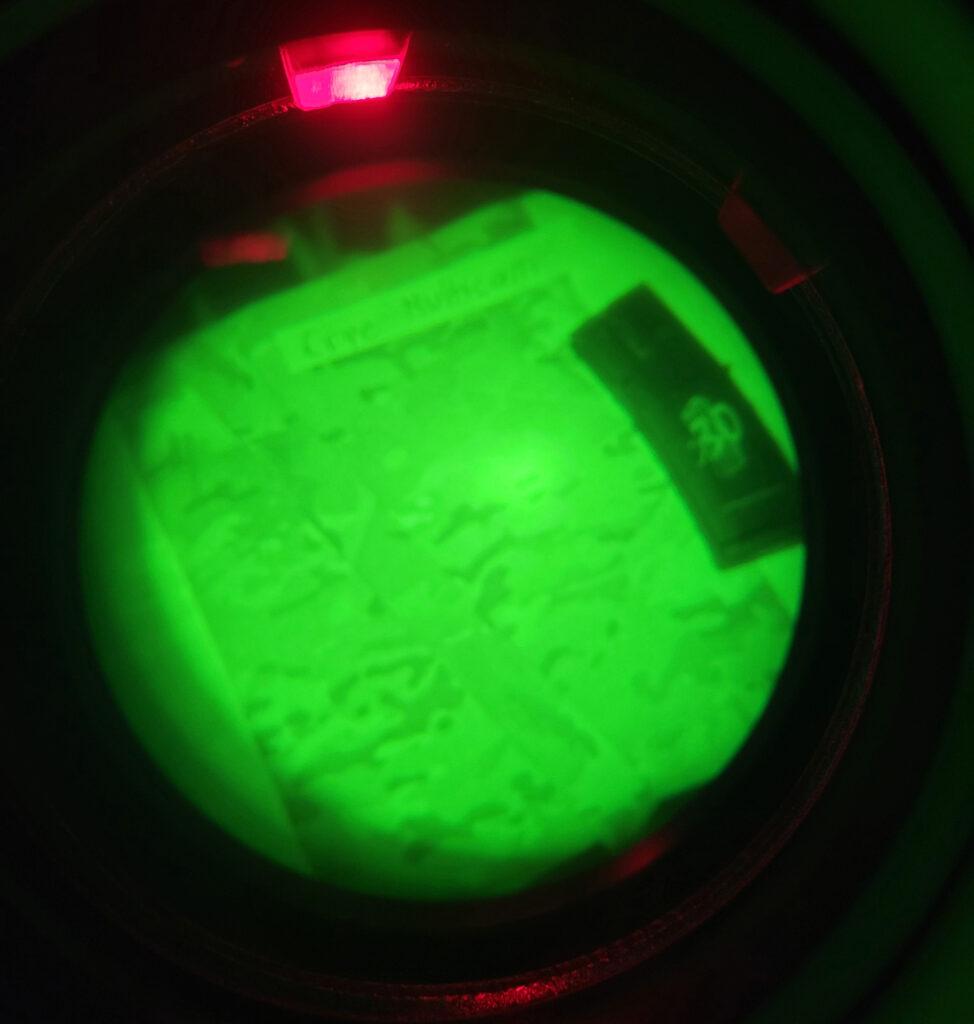
Crye Precision MultiCam Arid
500 Denier CORDURA fabric purchased from Brookwood Roll Goods.
Mil-W-17337 webbing purchased from Texcel Industries
All officially licensed material.
Basically the same results as the original MultiCam pattern. Excellent.
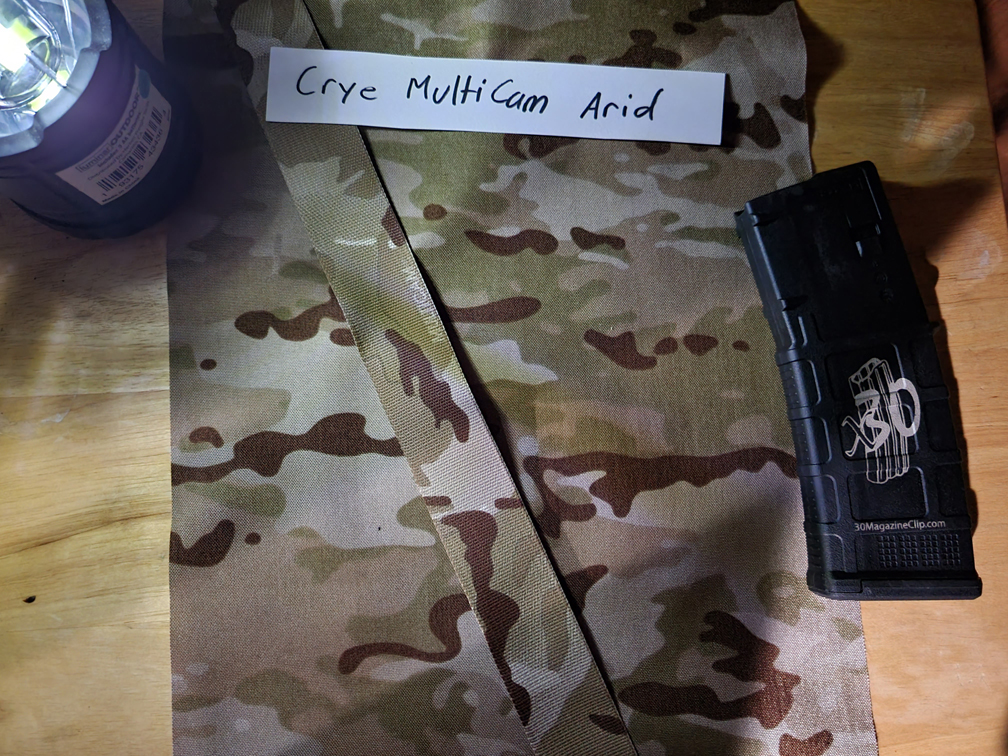
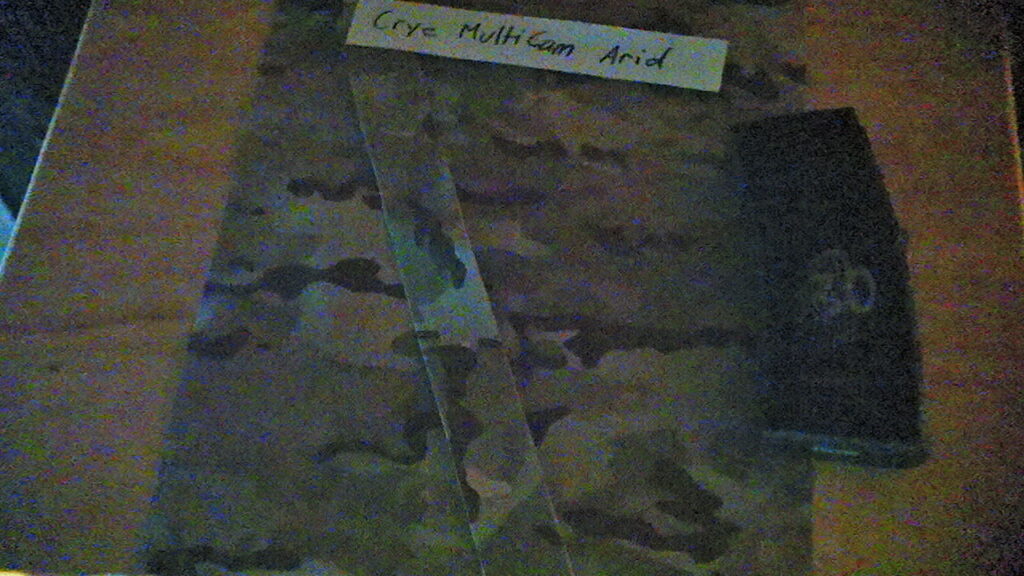
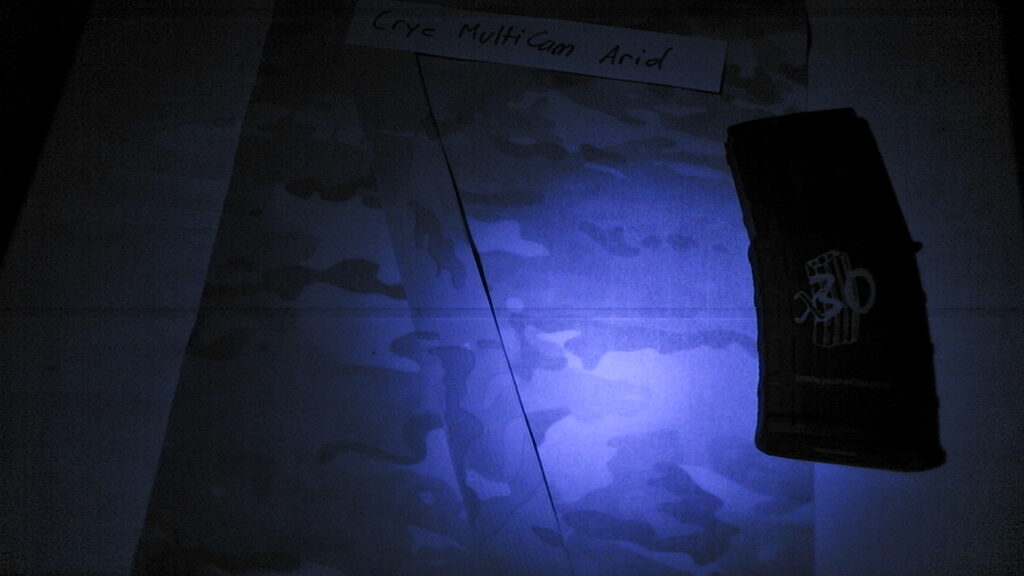
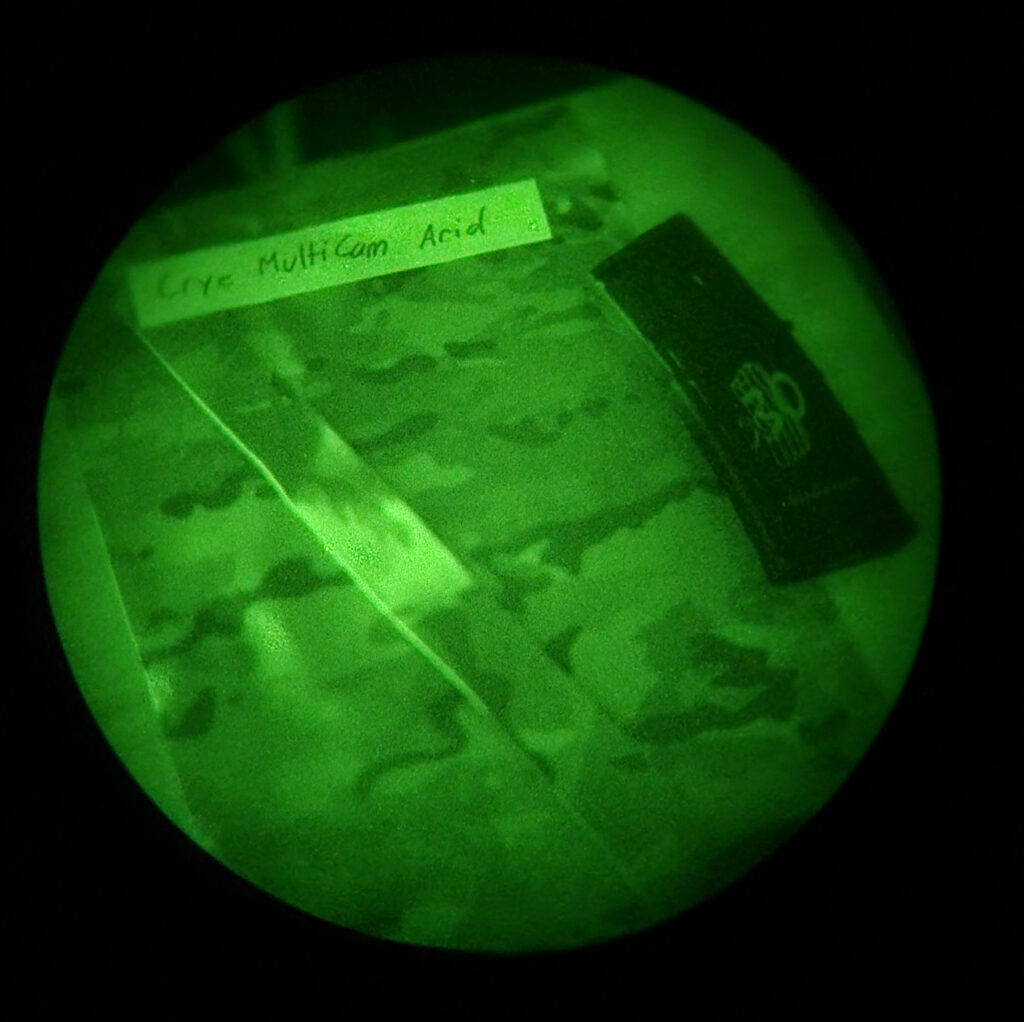
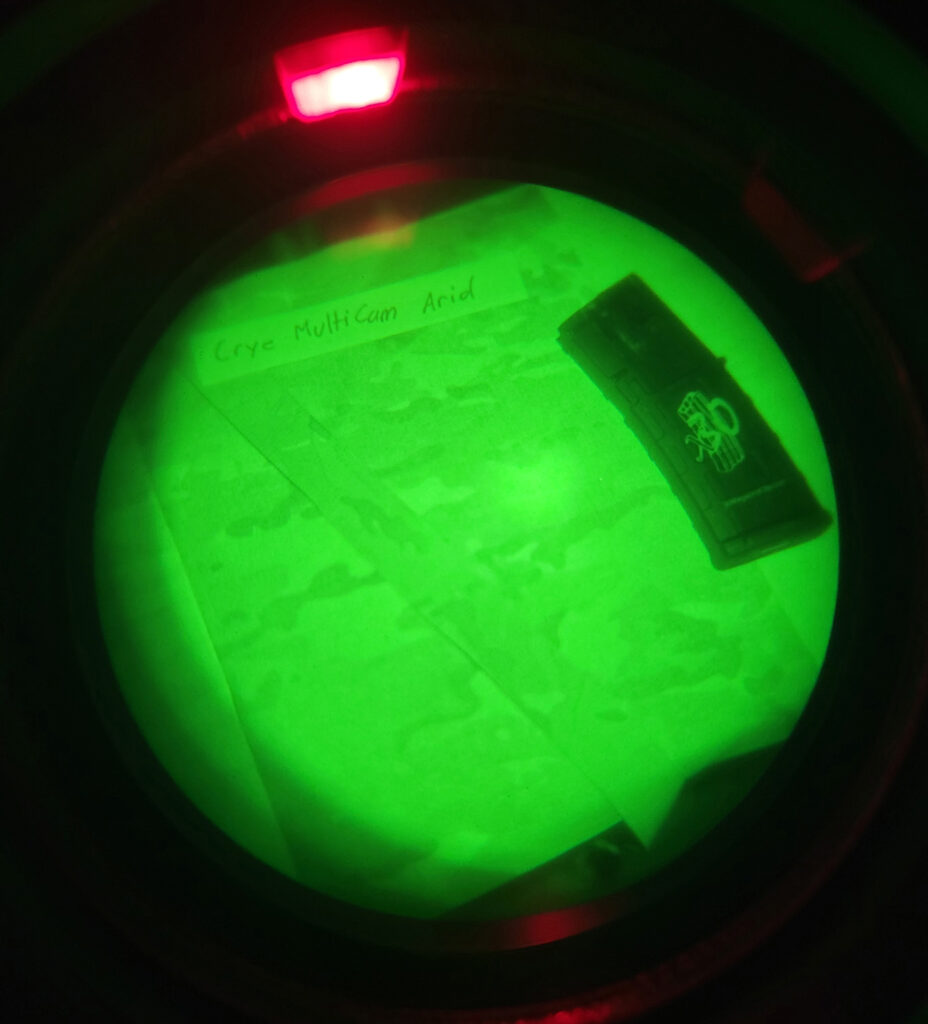
Crye Precision MultiCam Black
500 Denier CORDURA fabric purchased from Brookwood Roll Goods.
Webbing left: MIL-W-17337 from Texcel Industries.
Webbing right: MIL-W-17337 from MMI Textiles
All officially licensed materials.
While both the fabric and the two samples of webbing are all NIR you can see how the fabric lightens quite a bit while the webbing stays darker. This is an inherent issue with using darker patterns/dye. By the nature of light it all gets soaked up pretty good no matter the light spectrum. The webbing performed about as good as I though. What surprised me was how the fabric itself lightened up so much. Contrary to popular belief a dark pattern is not what you generally want to use at night if you are worried about an opponent with NODs.
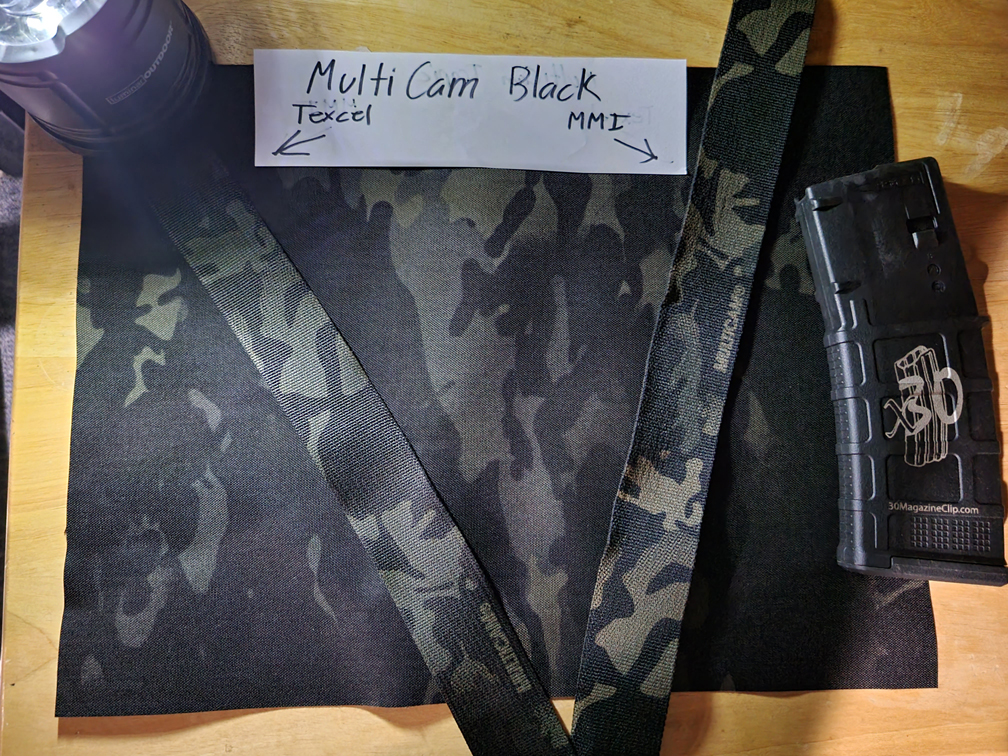
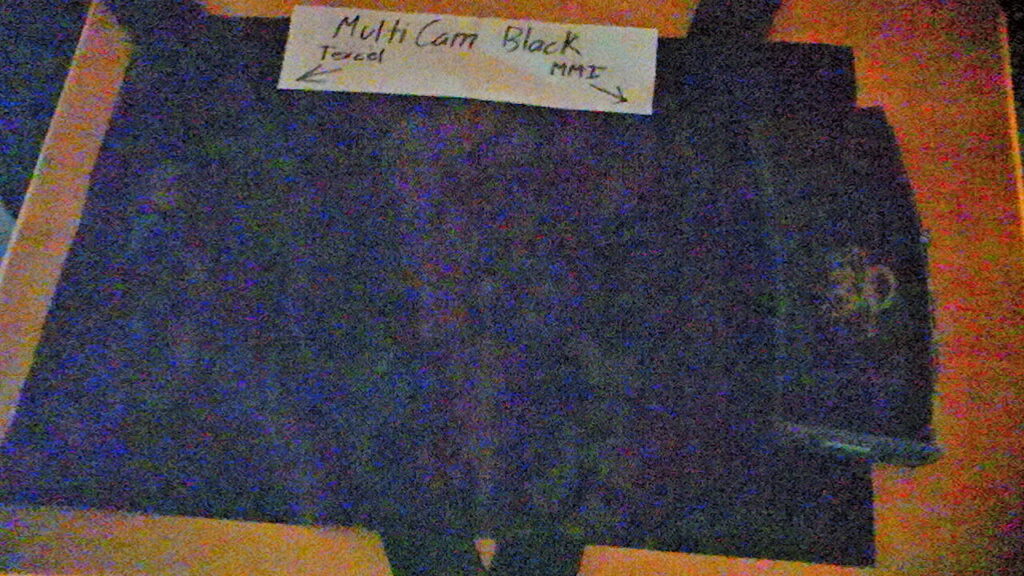
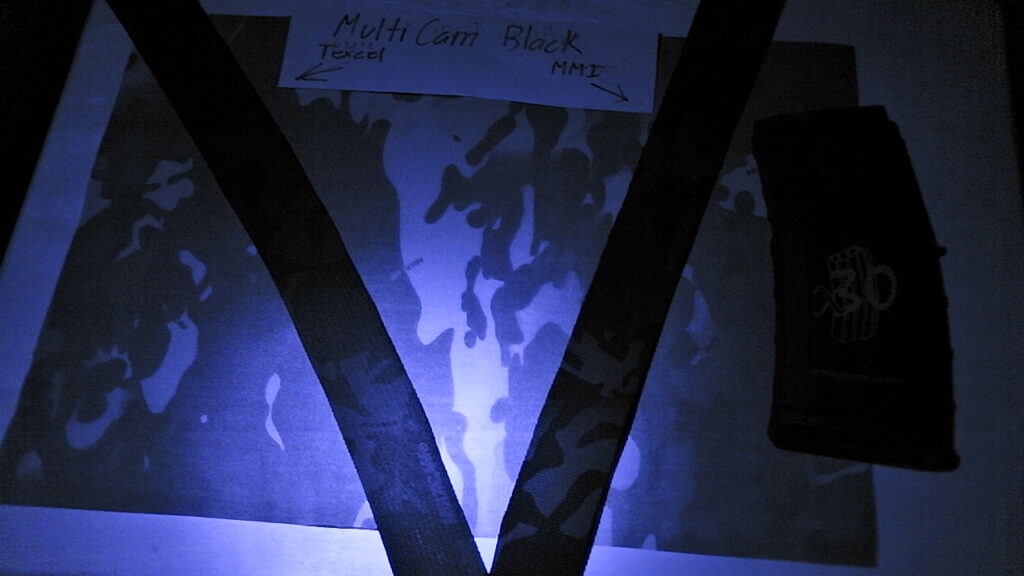
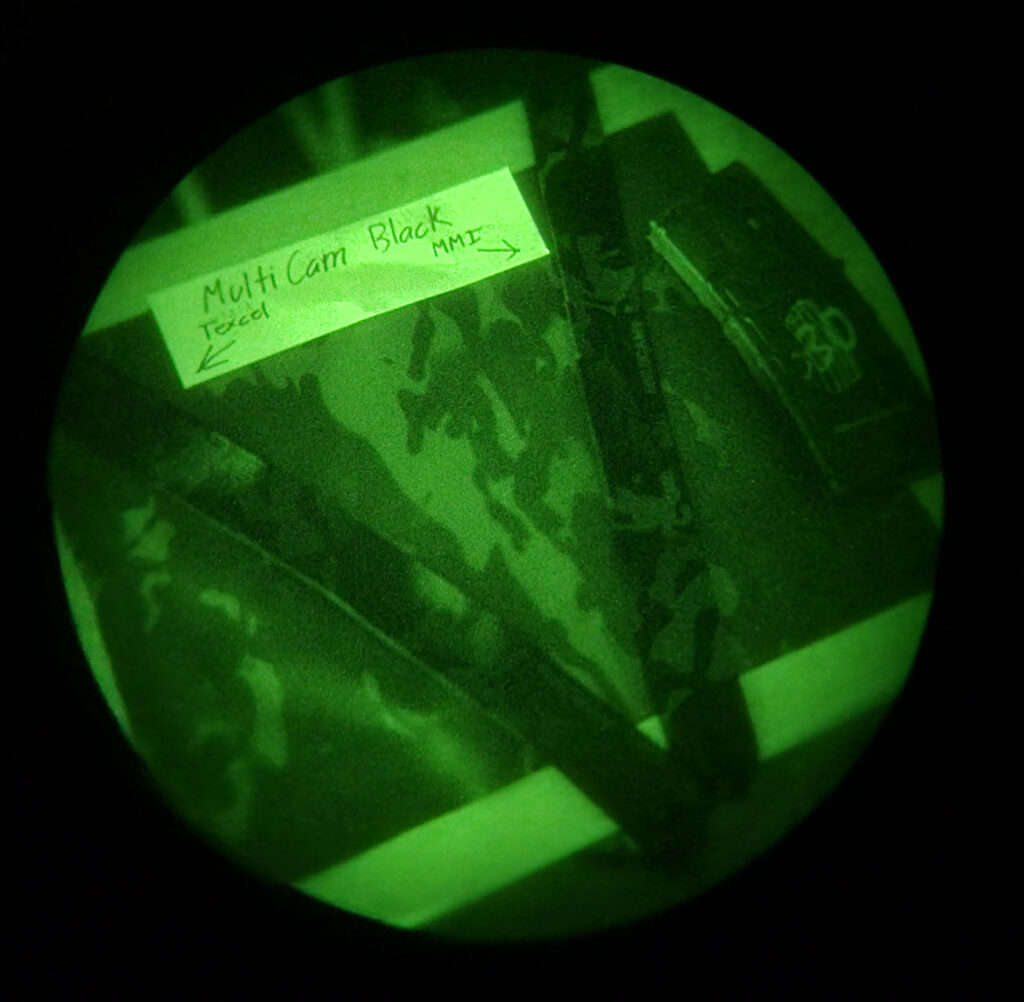
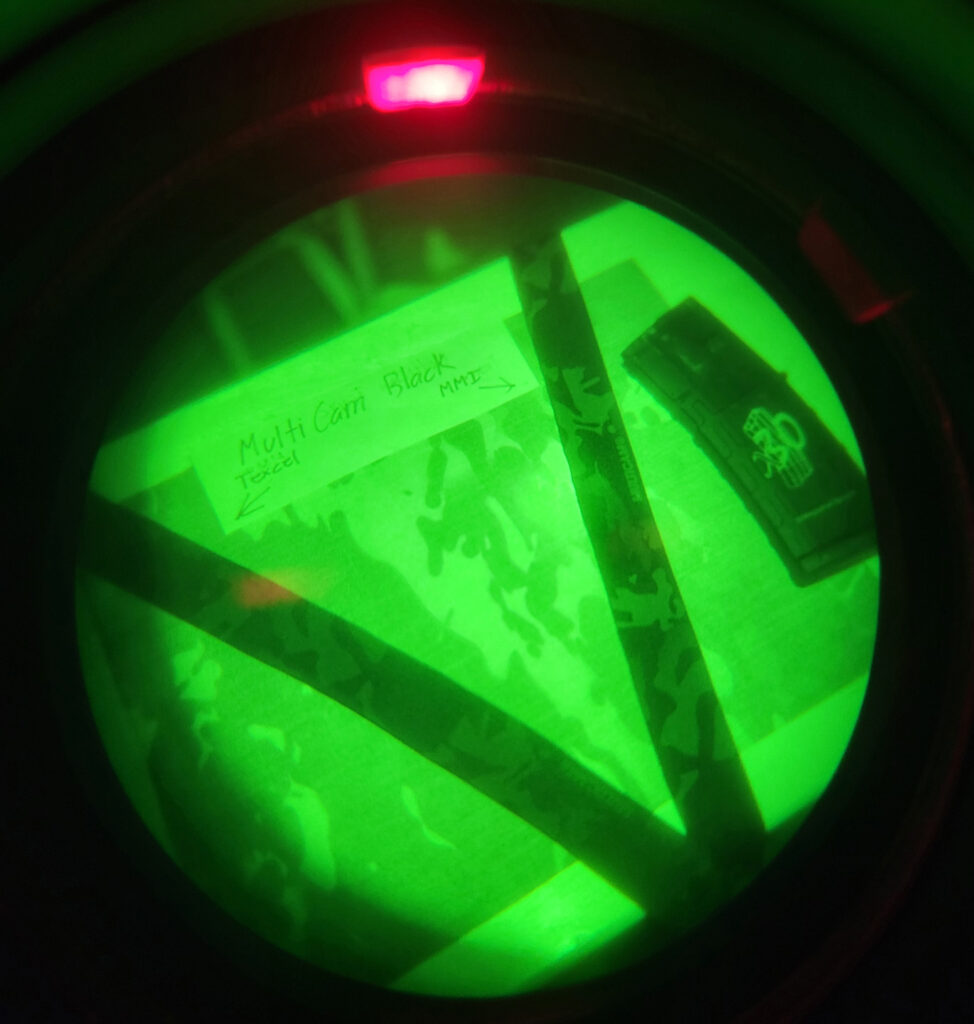
Crye Precision MultiCam Tropic
500 Denier CORDURA fabric purchased from Brookwood Roll Goods.
Webbing left: MIL-W-17337 from Texcel Industries.
Webbing right: MIL-W-17337 from MMI Textiles
All officially licensed materials.
The MMI licensed webbing seems to more accurately reflect (literally) the IR light in the same manner as the fabric. Although the Texcel product actually maintains its original properties better and is the clear “IR-winner” here. So you would need to ask yourself. Do you want materials that act the same together although not as good (MMI) or do you want the better performance from each individual components (Texcel).
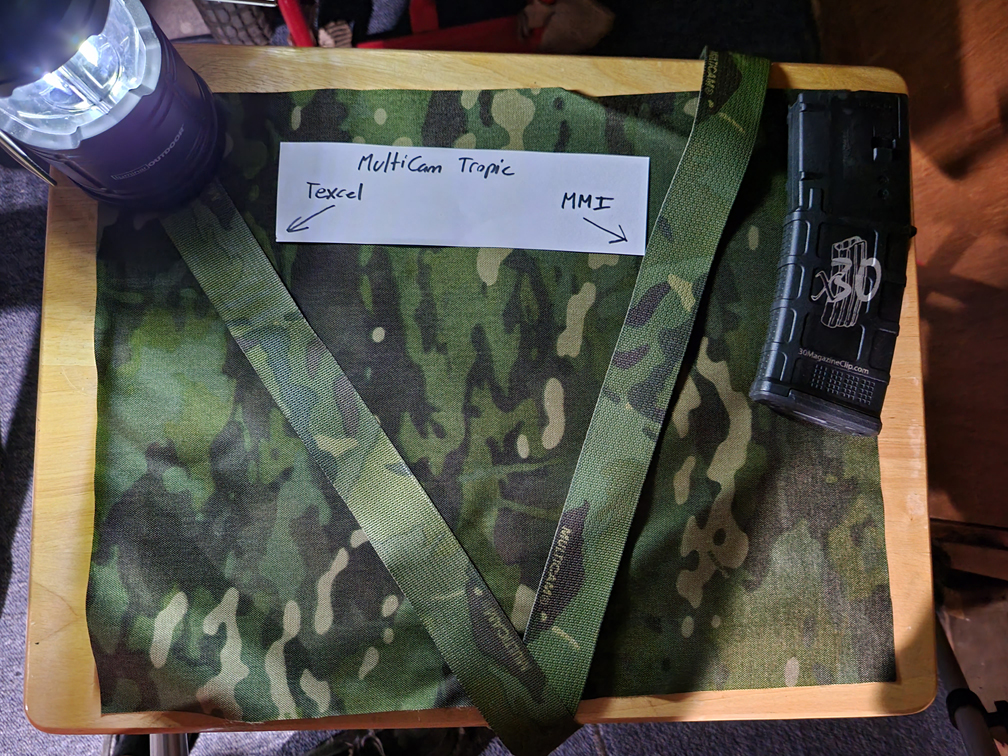
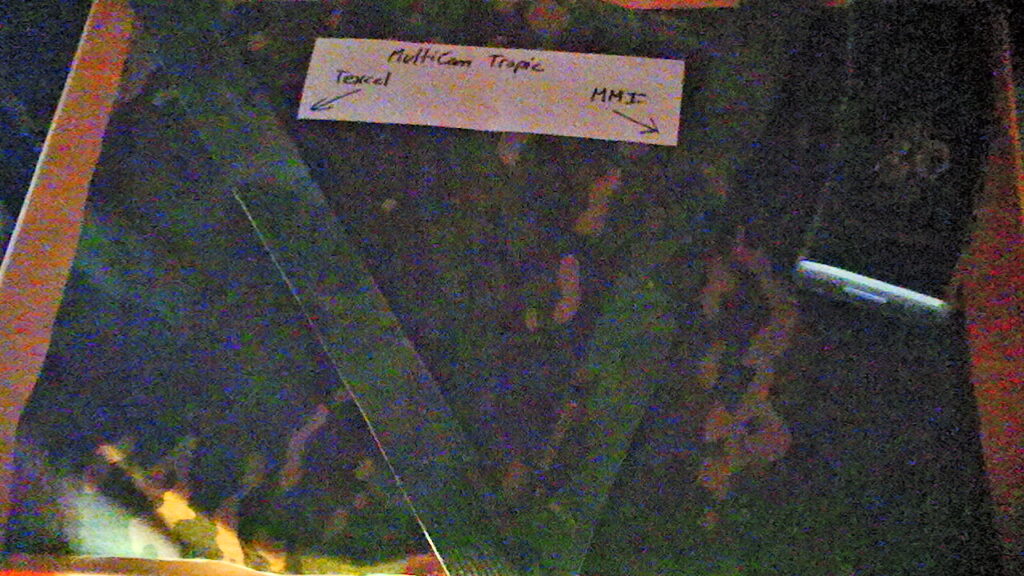
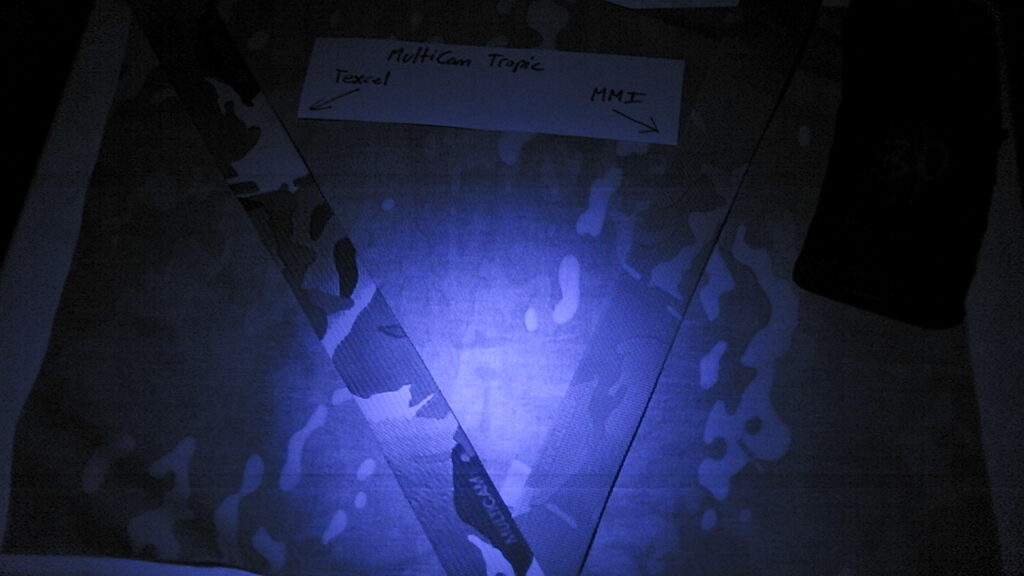
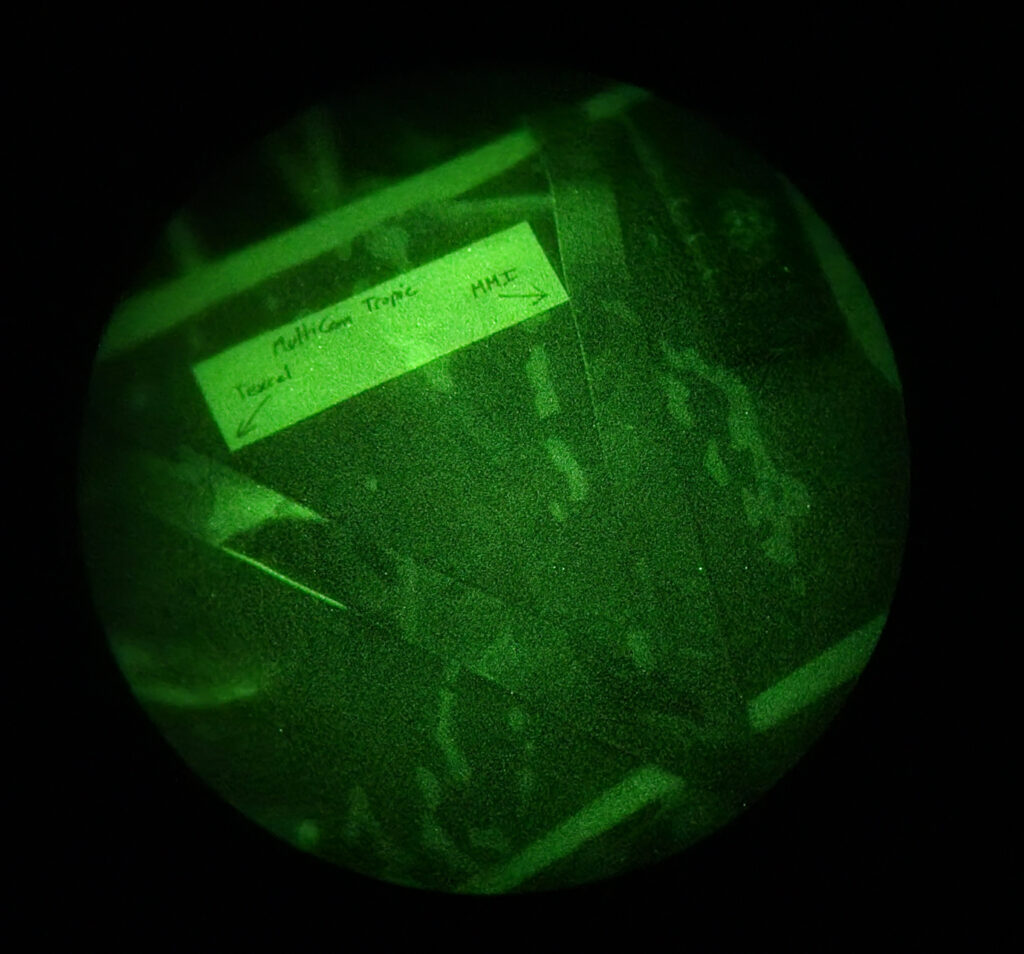
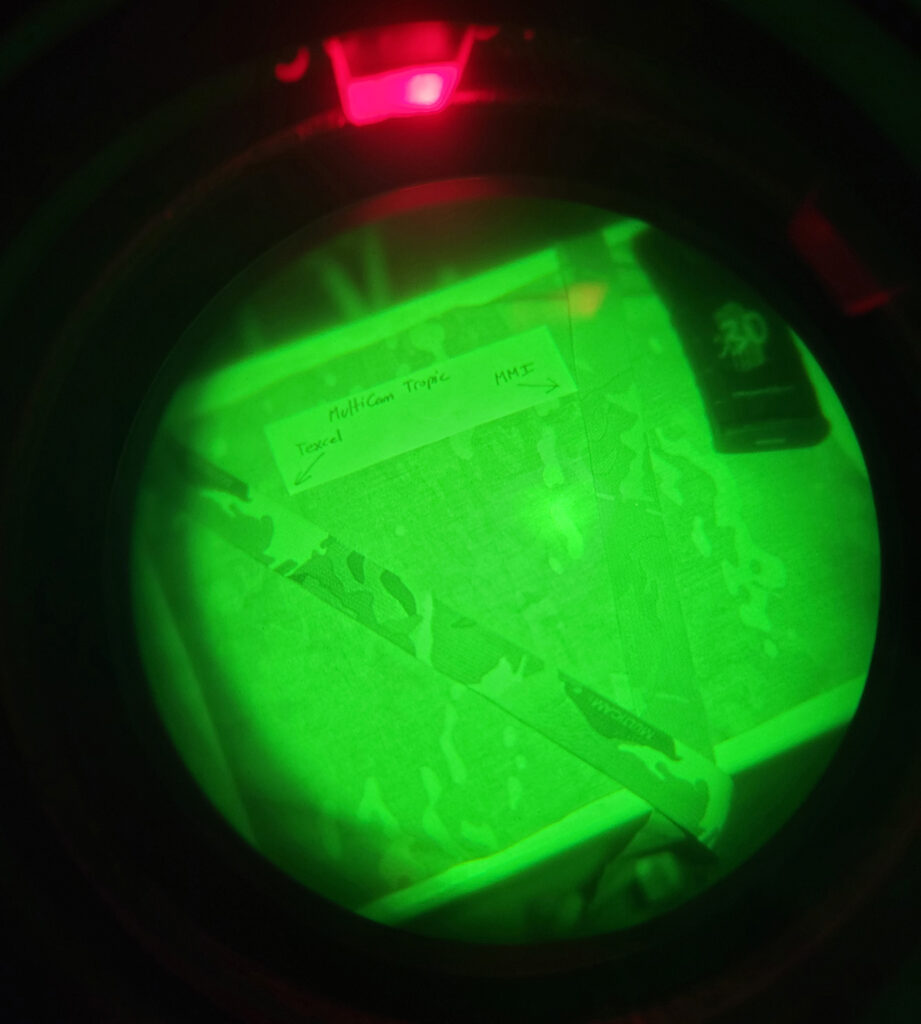
Desert Night Camo (DNC)
500 Denier CORDURA fabric purchased from MOS Tactical.
Well, the test is not without its sense of irony. Not great with the IR results here for something literally called “Night Camo”. The pattern completely disappears when reflecting IR light weather under digital or gen3 analogue Night Vision. To be completely fair the buy page on MOS Tactical says nothing about NIR for this material but it would be easy to assume it should be.
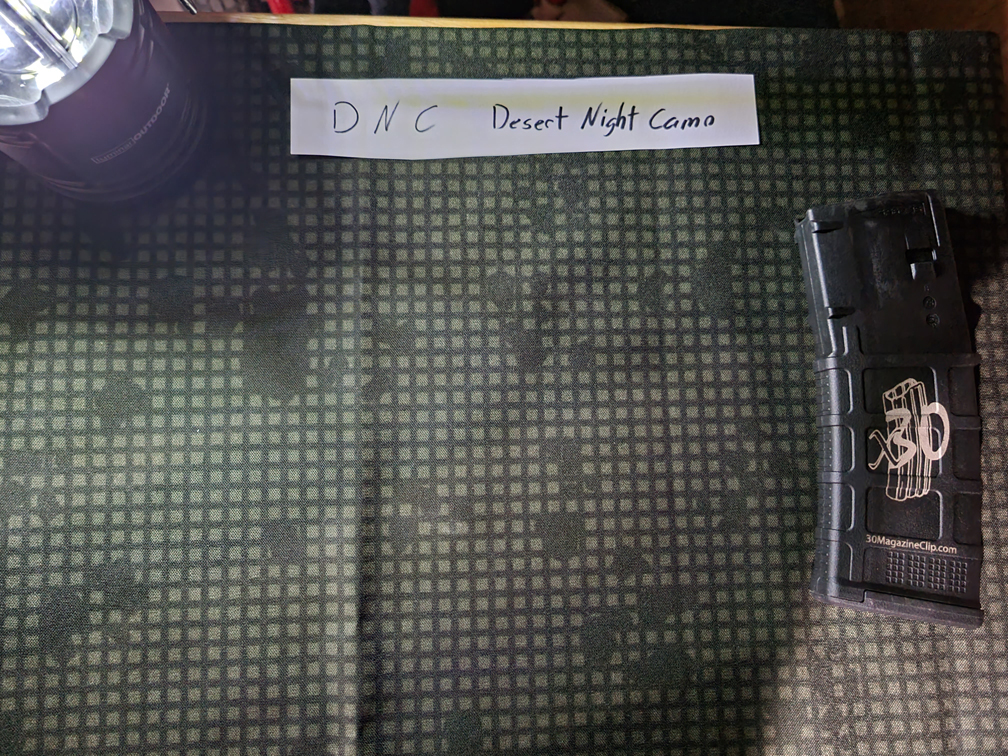
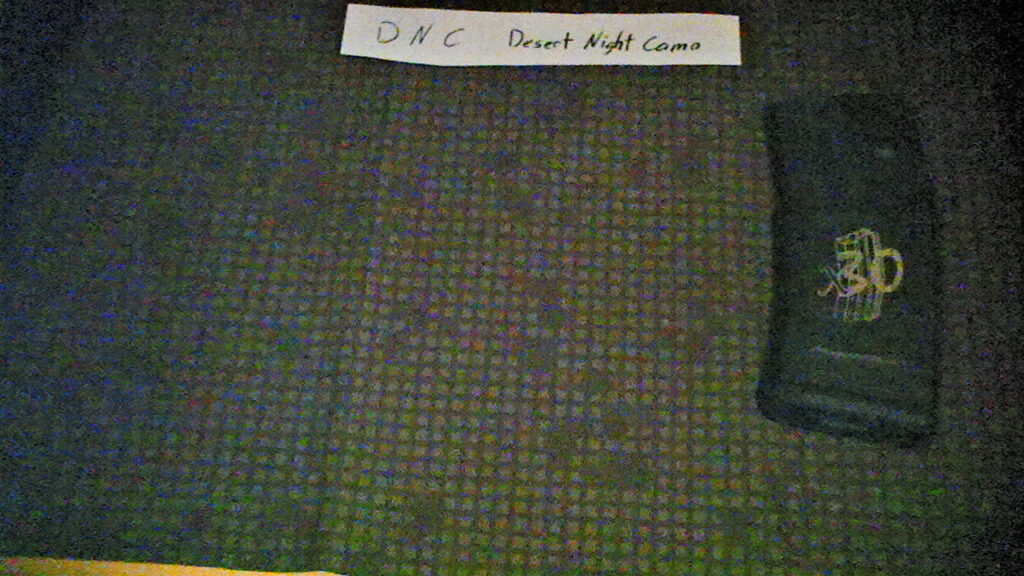
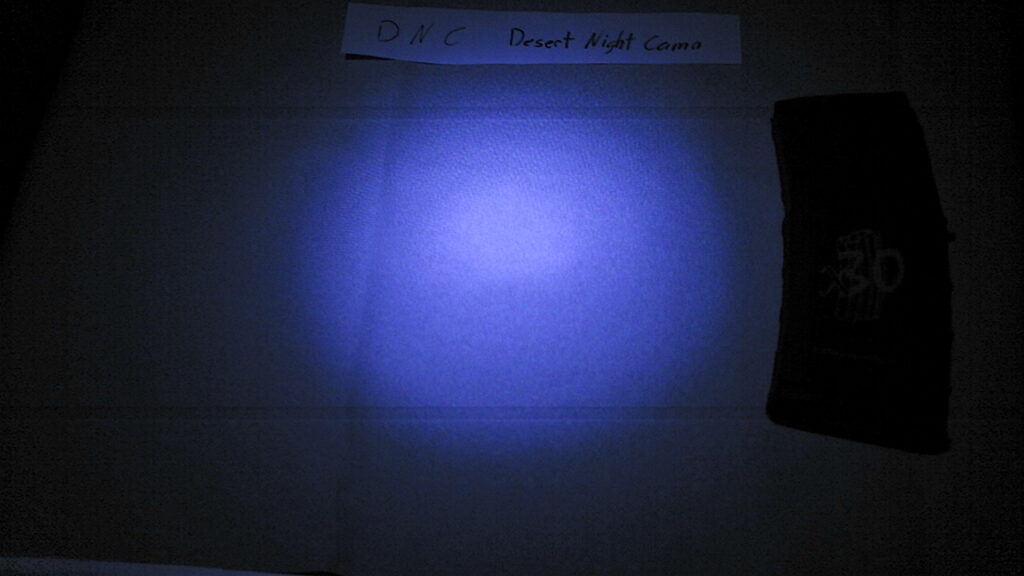
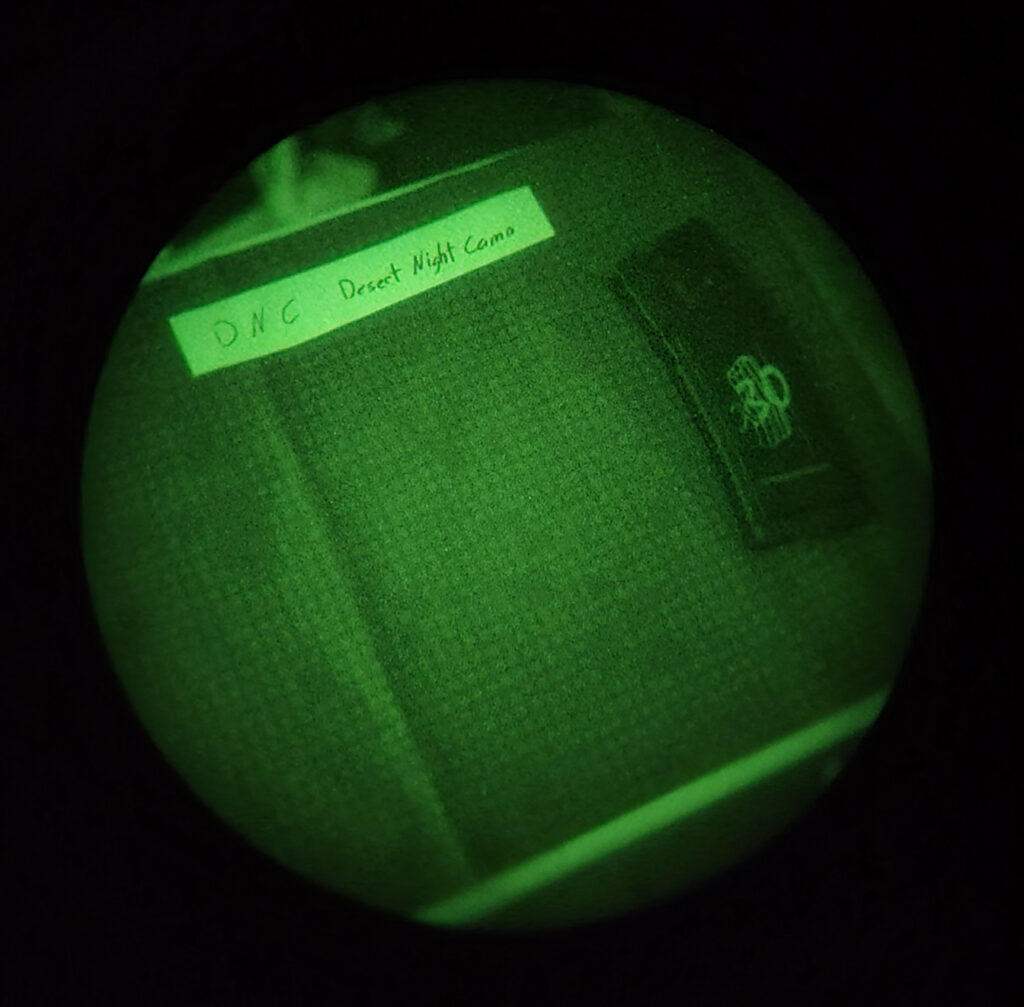
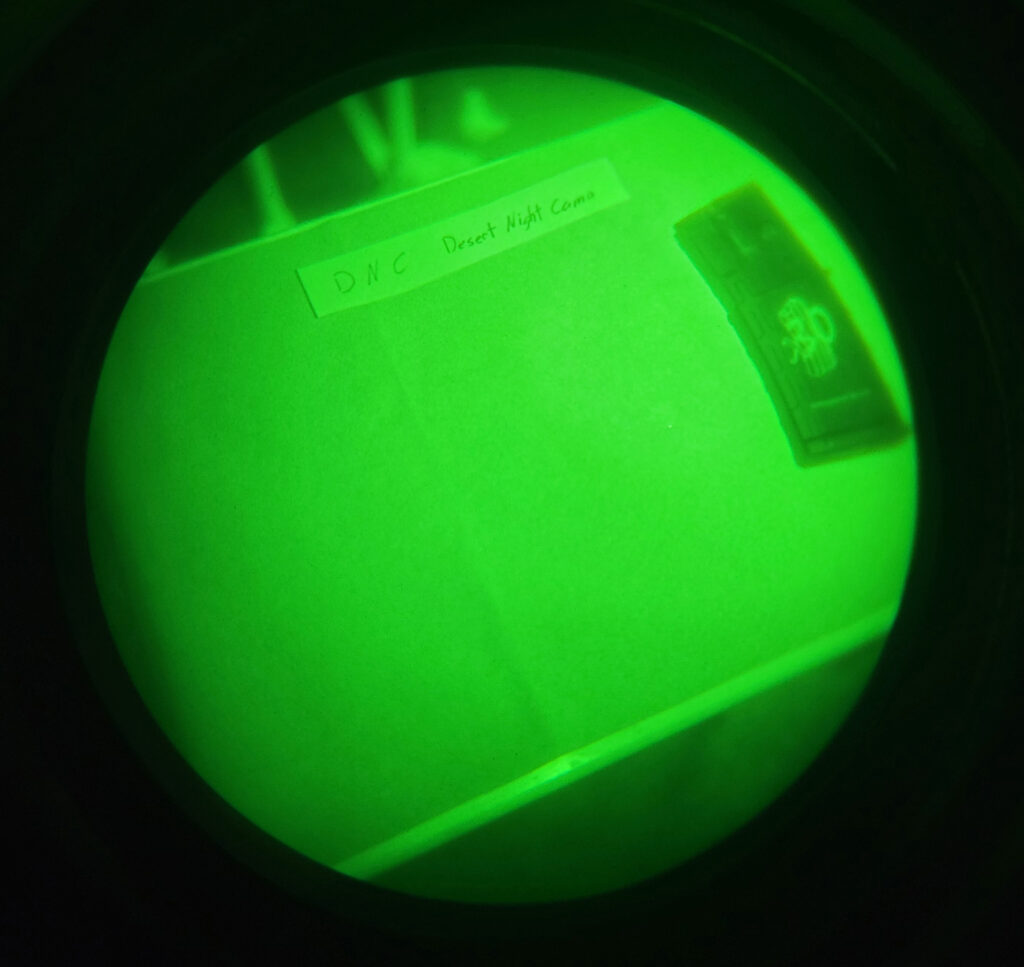
Kryptek Highlander
1000 Denier CORDURA fabric. Licensed material. Purchased from Brookwood Roll Goods.
Webbing (on pack) MIL-W-17337 from Texcel Industries. Licensed Material.
Not the best results but not horrible at all. Under IR the fabric and webbing perform almost identically which is great. The pattern is washed out quite a bit which is what you rely on with camo to break up your human form. But it is still there.

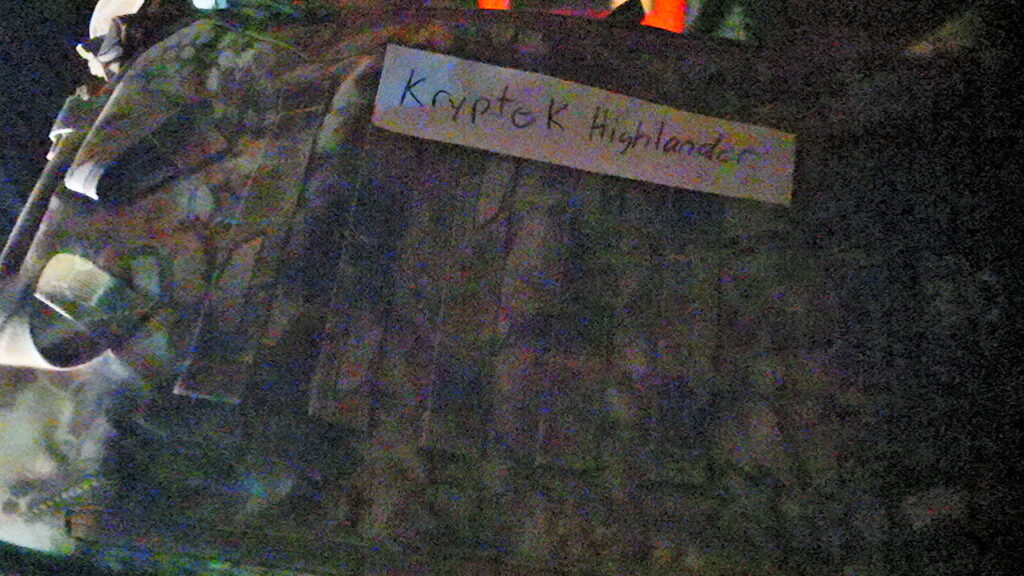
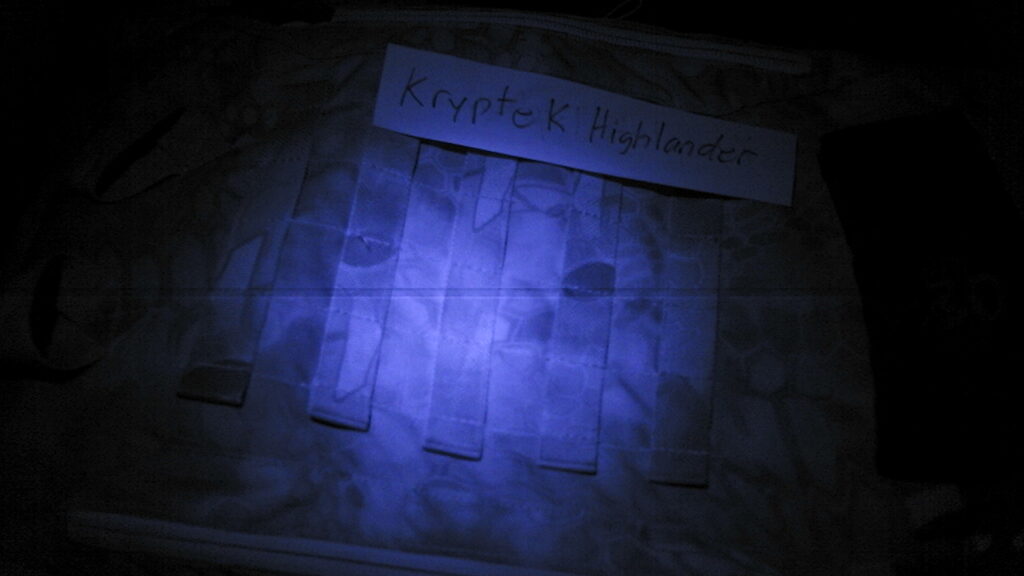
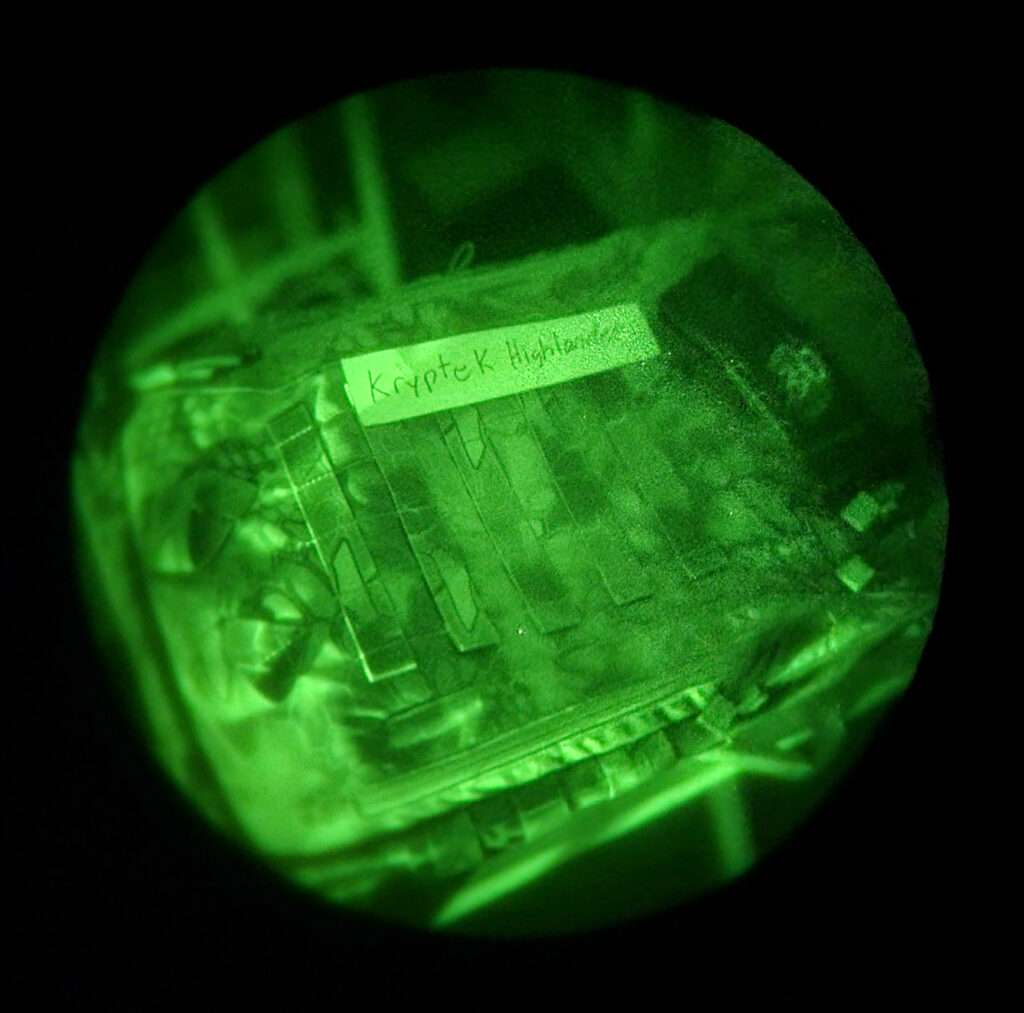
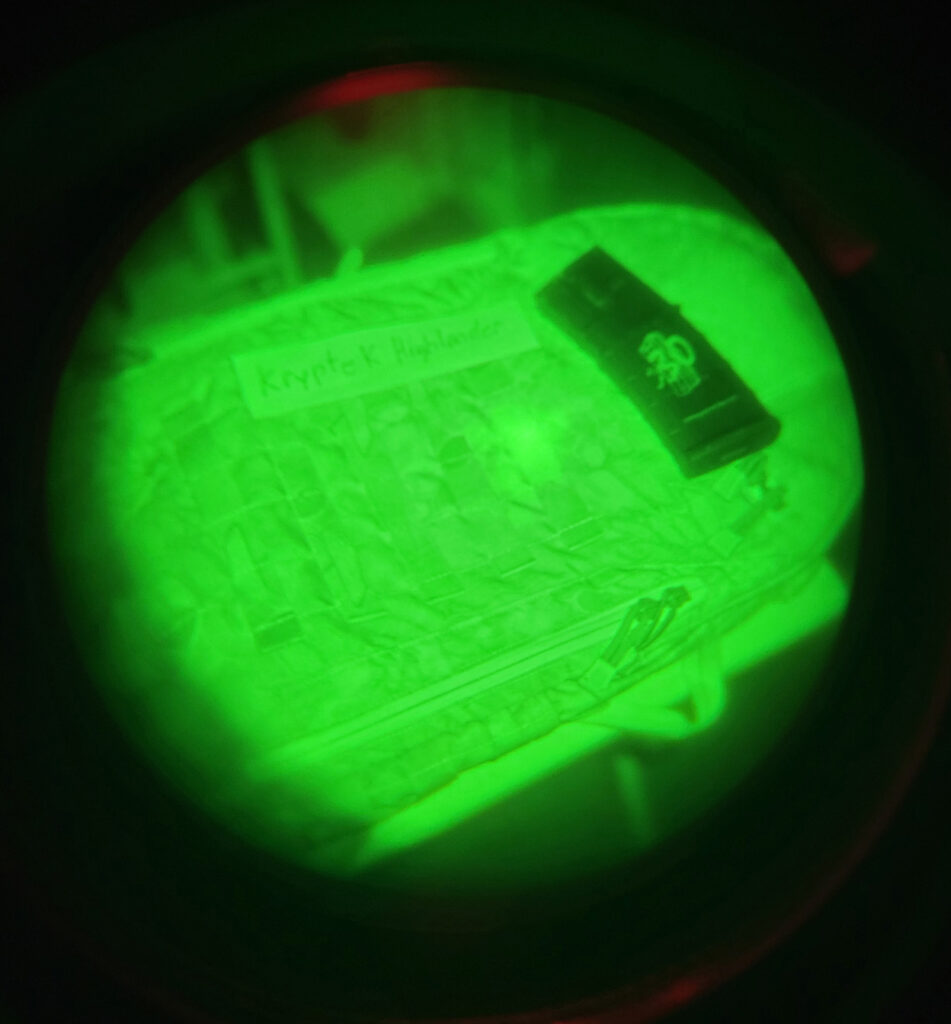
Kryptek Highlander (Dye Sublimation)
1000 Denier CORDURA HP fabric. Licensed material. Purchased from DutchWare via Print on Demand fabric service. See traditional screen printed material above.
The Dye Sublimated printing does not do well under IR. Well, it does nothing. It just disappears.
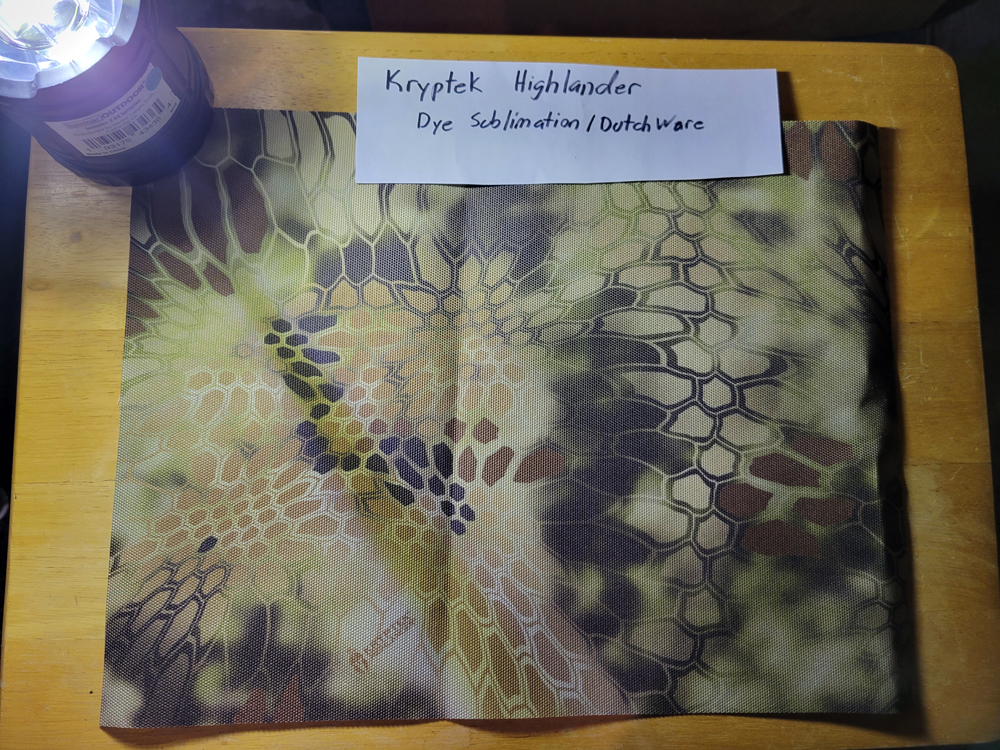
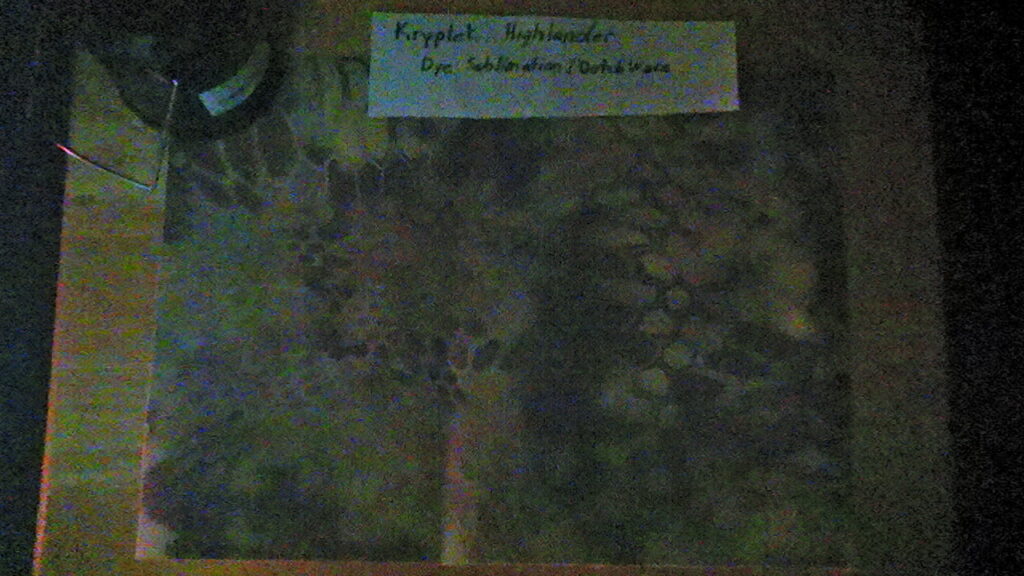
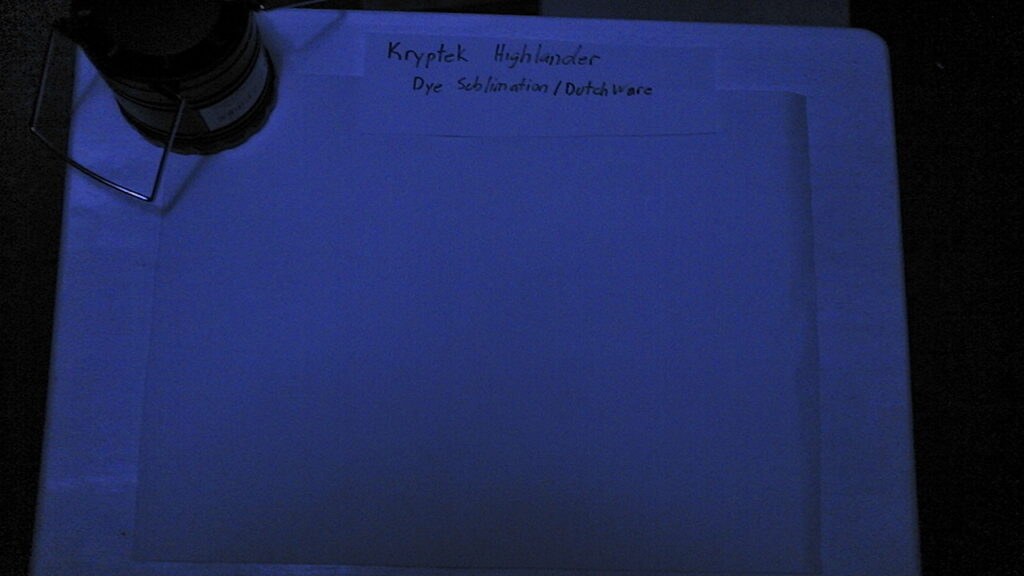
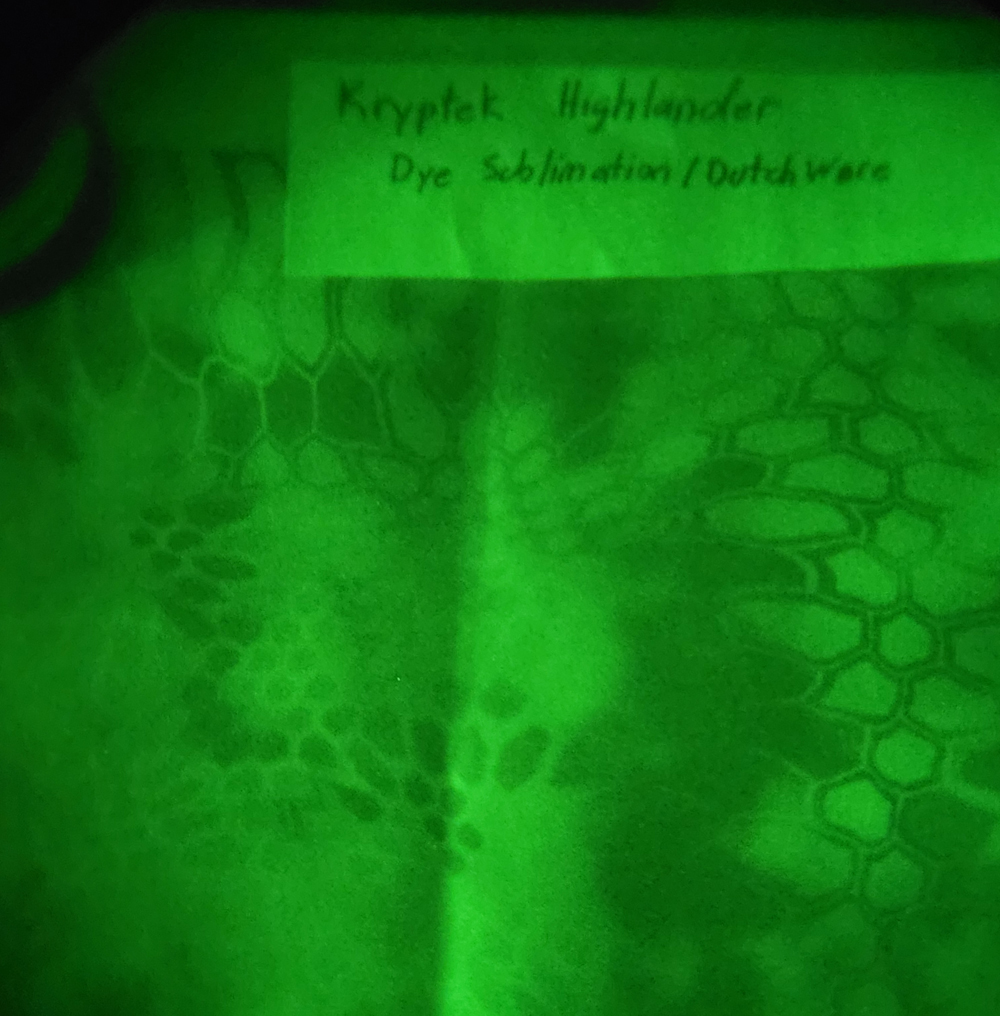
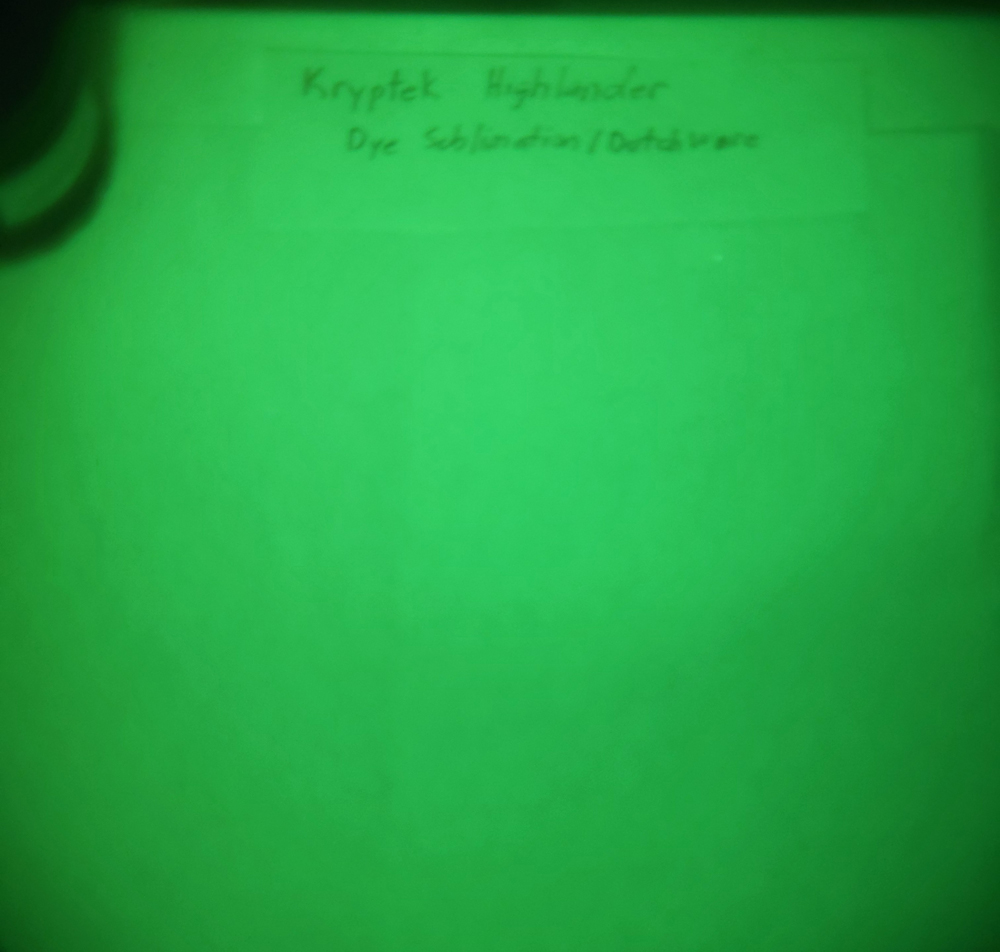
HyperStealth Spec4CE Forest
1000 Denier CORDURA fabric. Licensed material. Purchased from Rockywoods.
Writeup from the inventor.
Fairly good results under digital night vision w/IR but not nearly as good under gen3 analogue where the pattern mostly disappears when IR light is introduced. Although keep in mind this is basically the worst case scenario where the IR light source is only about a yard away from the material.
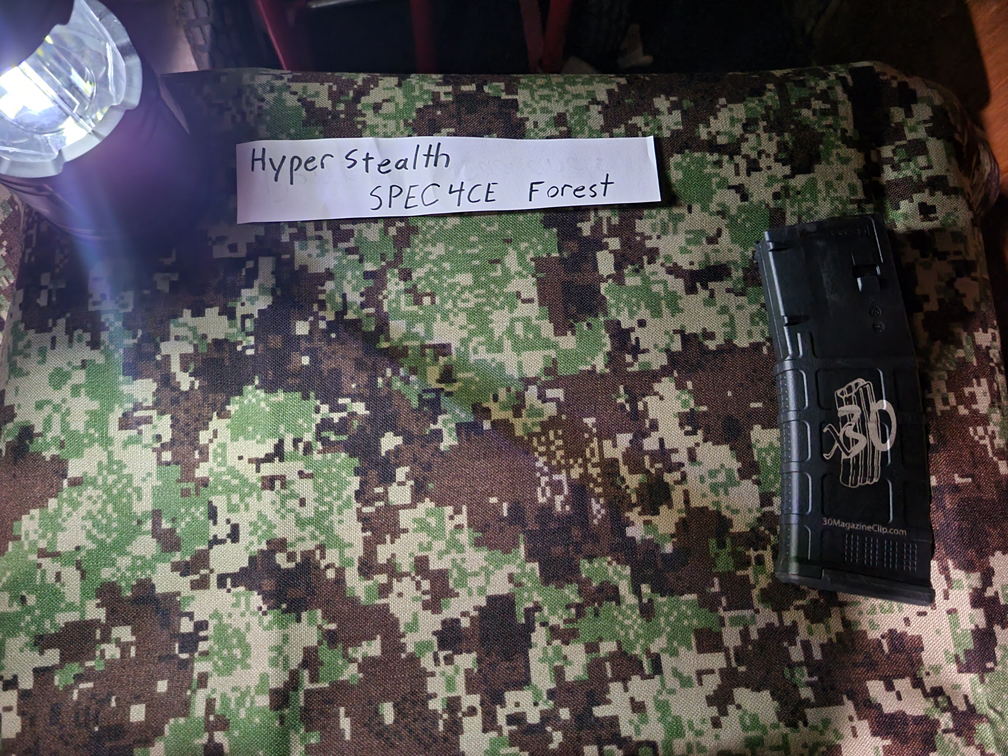
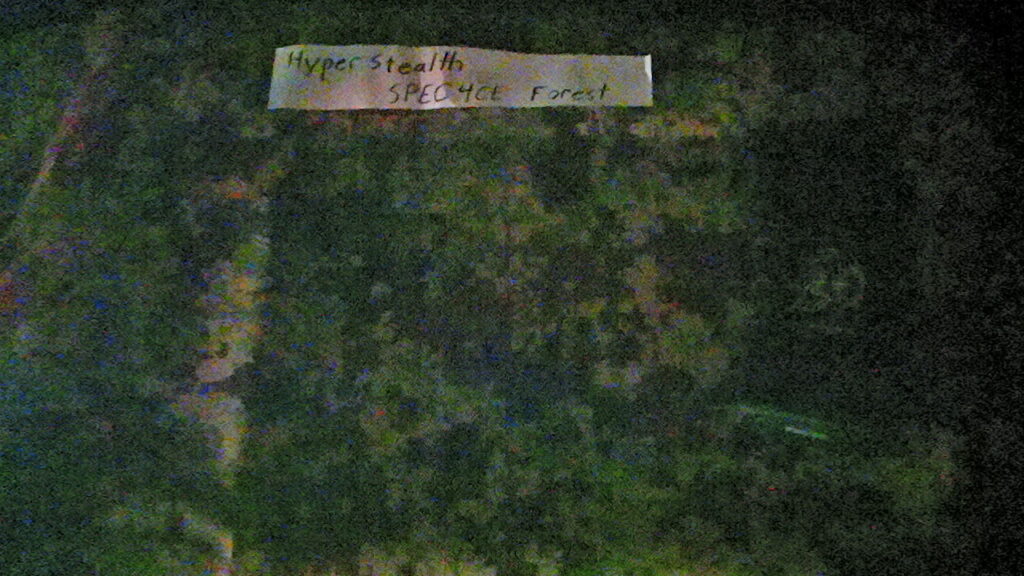
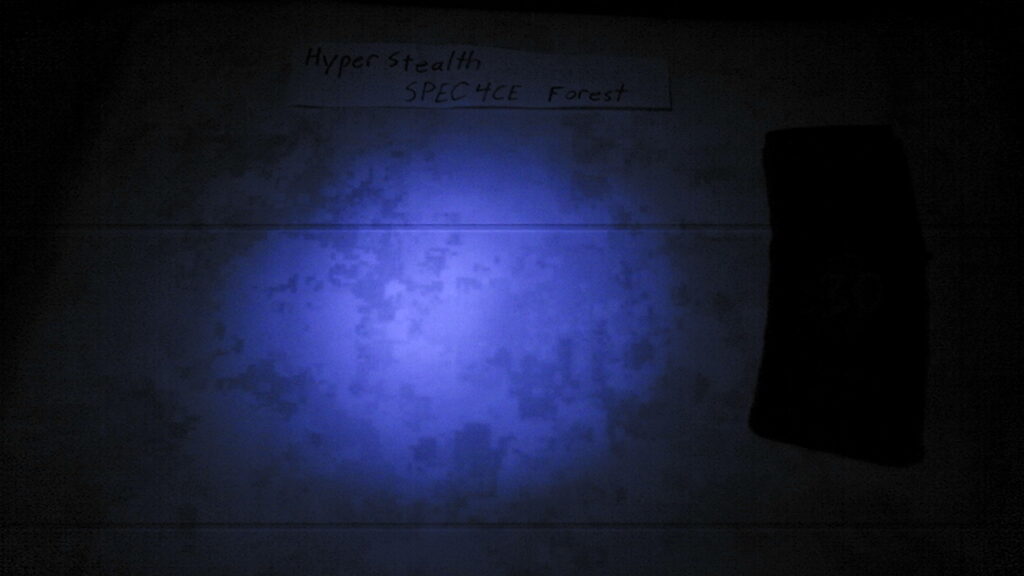
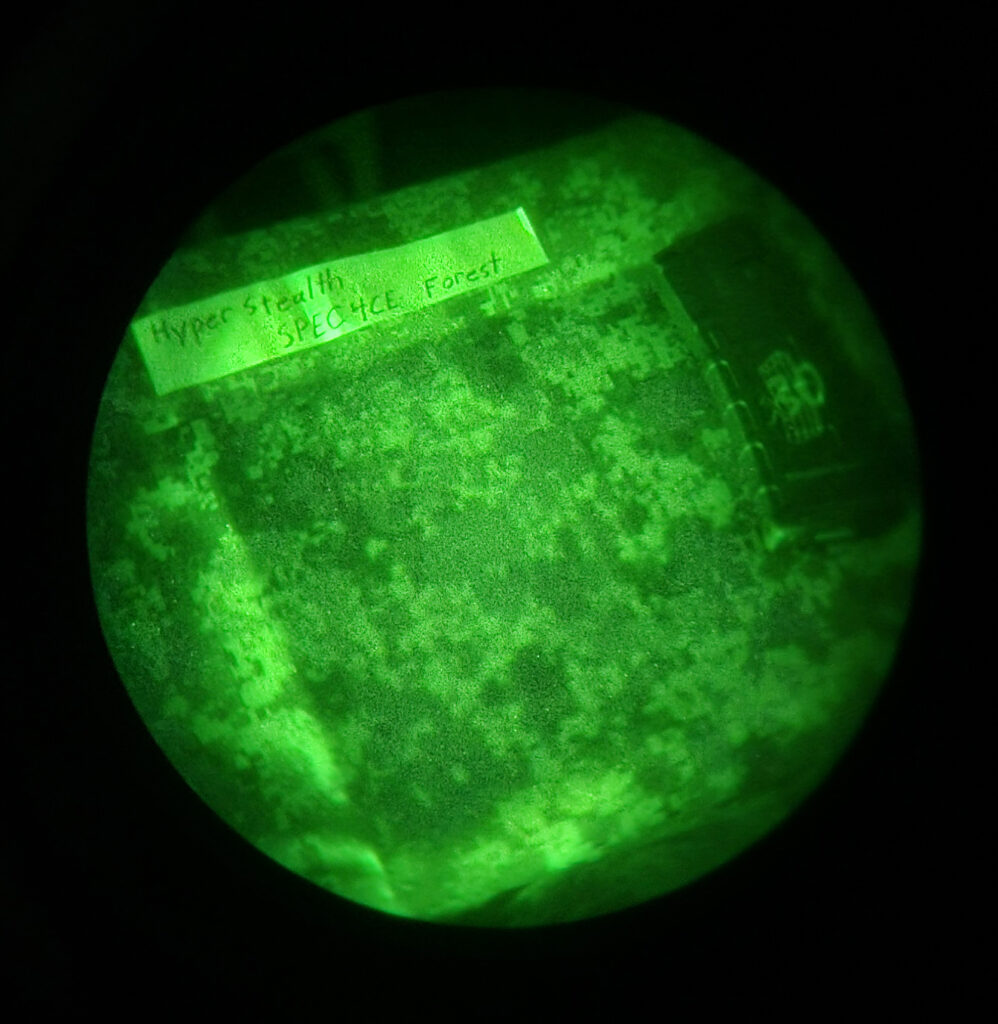
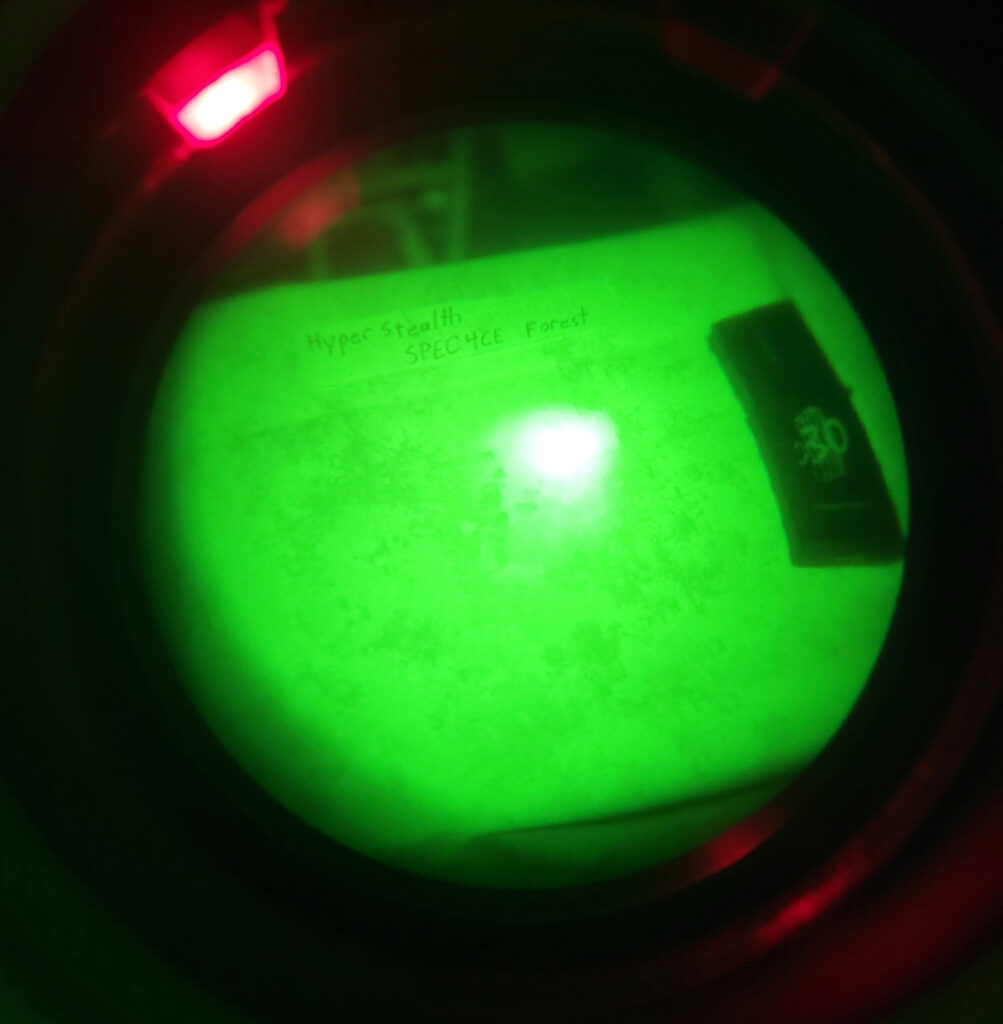
M81 Woodland
1000 Denier CORDURA fabric. Purchased from Brookwood Roll Goods.
Not the worst results even by modern standards. So pretty outstanding coming from an older pattern that is still in use. You can see under gen3 analogue night vision parts of the pattern disappear and parts stay in tact. This would probably still be to the positive in the field.
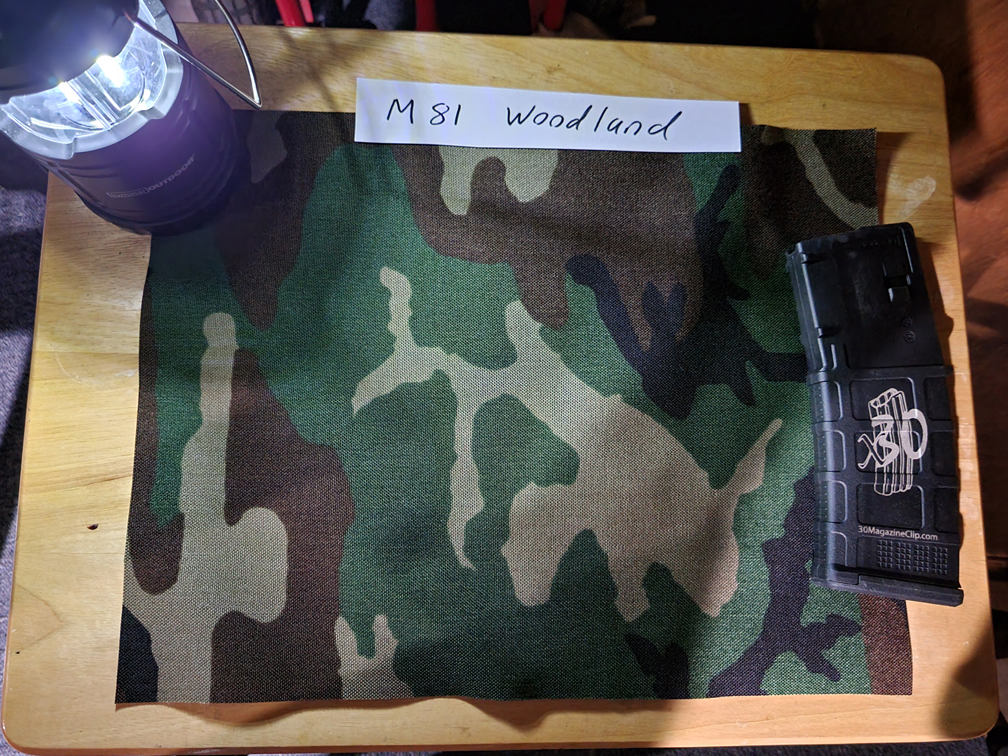
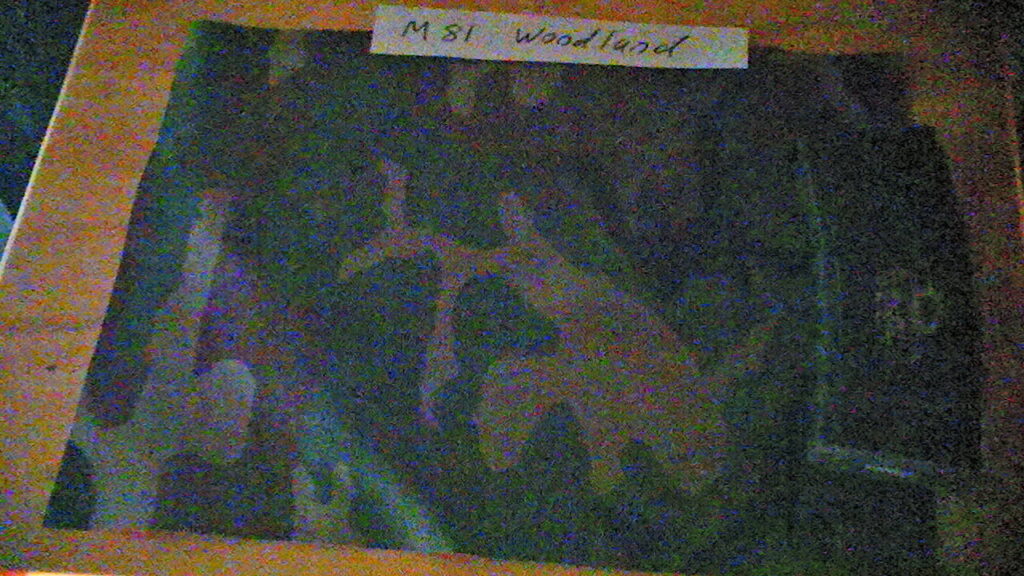
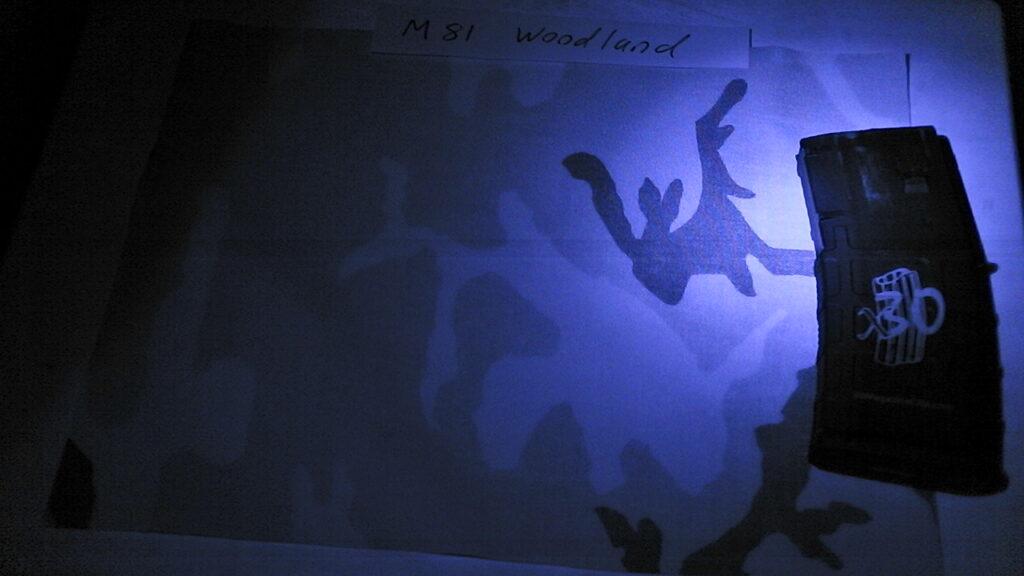
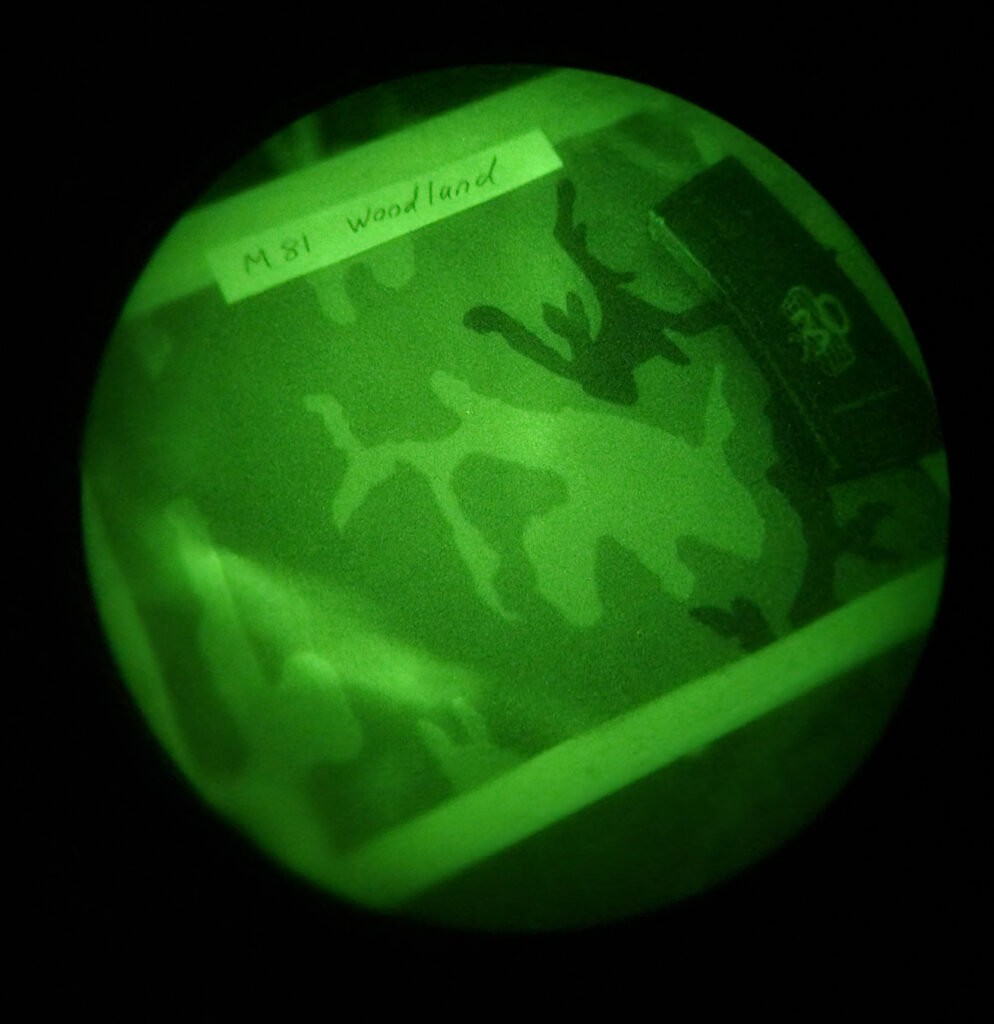
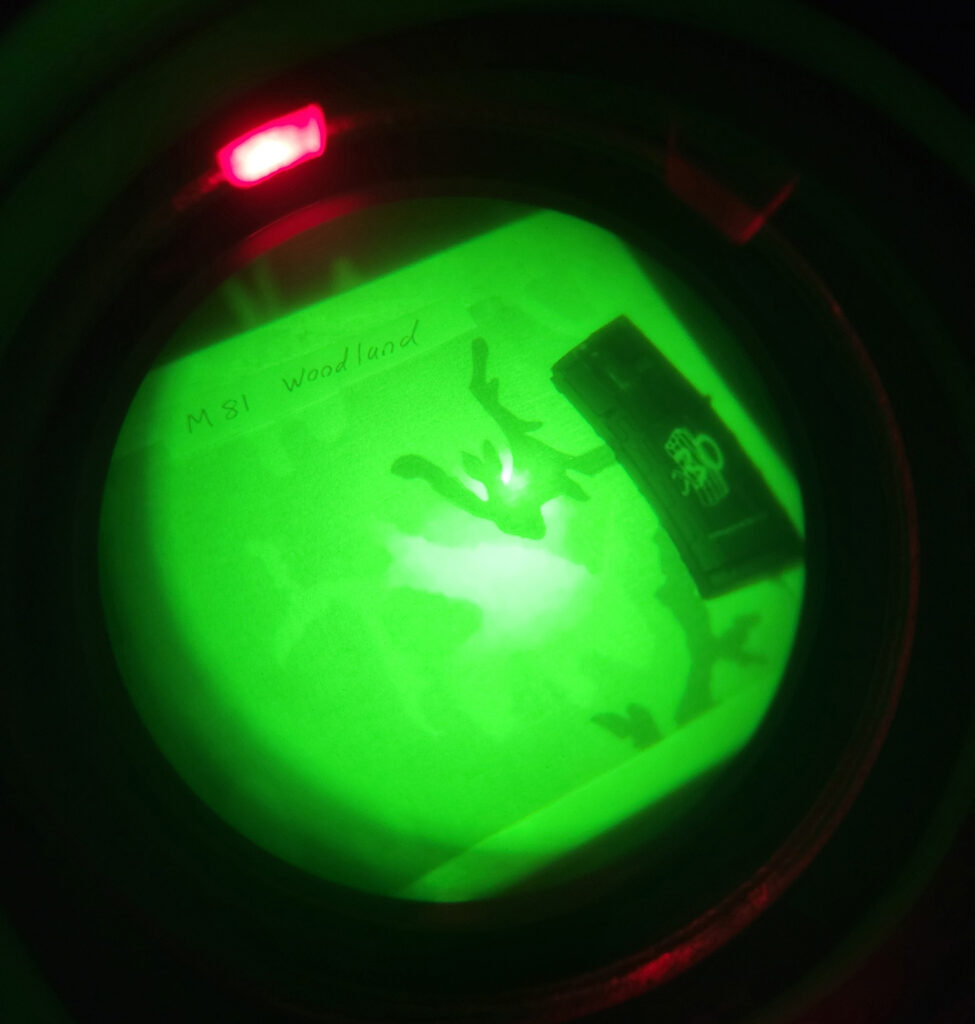
Kryptek Mandrake
1000 Denier CORDURA fabric. Licensed material. Purchased from Rockywoods.
Similar results to the Kryptek Highlander pattern. As far as Kryptek goes you are supposed to use the same webbing with Highlander and Mandrake fabric. They are a similar pattern as far as color. Mandrake being the green and Highlander being the “transitional” pattern. Sadly I didn’t have any webbing handy when taking the Mandrake picture. It stands to reason it would react nearly the same as the fully adequate results from Highlander.
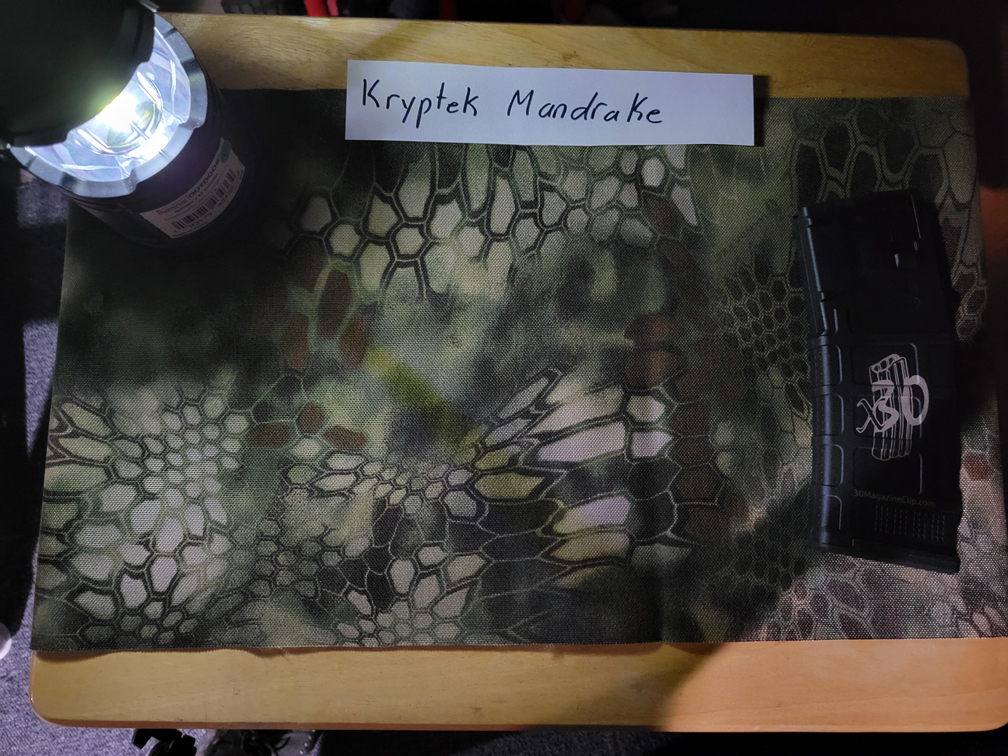
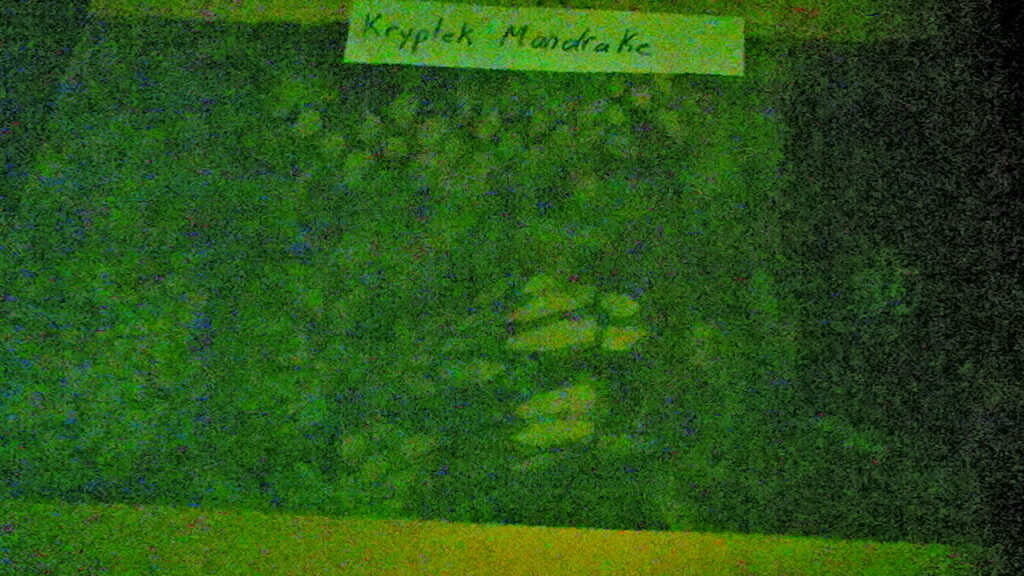
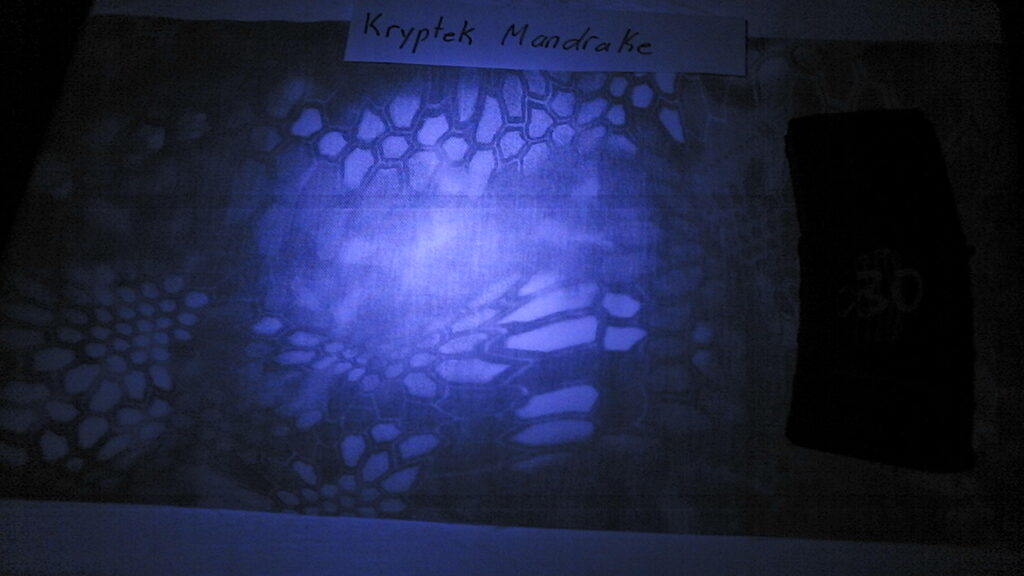
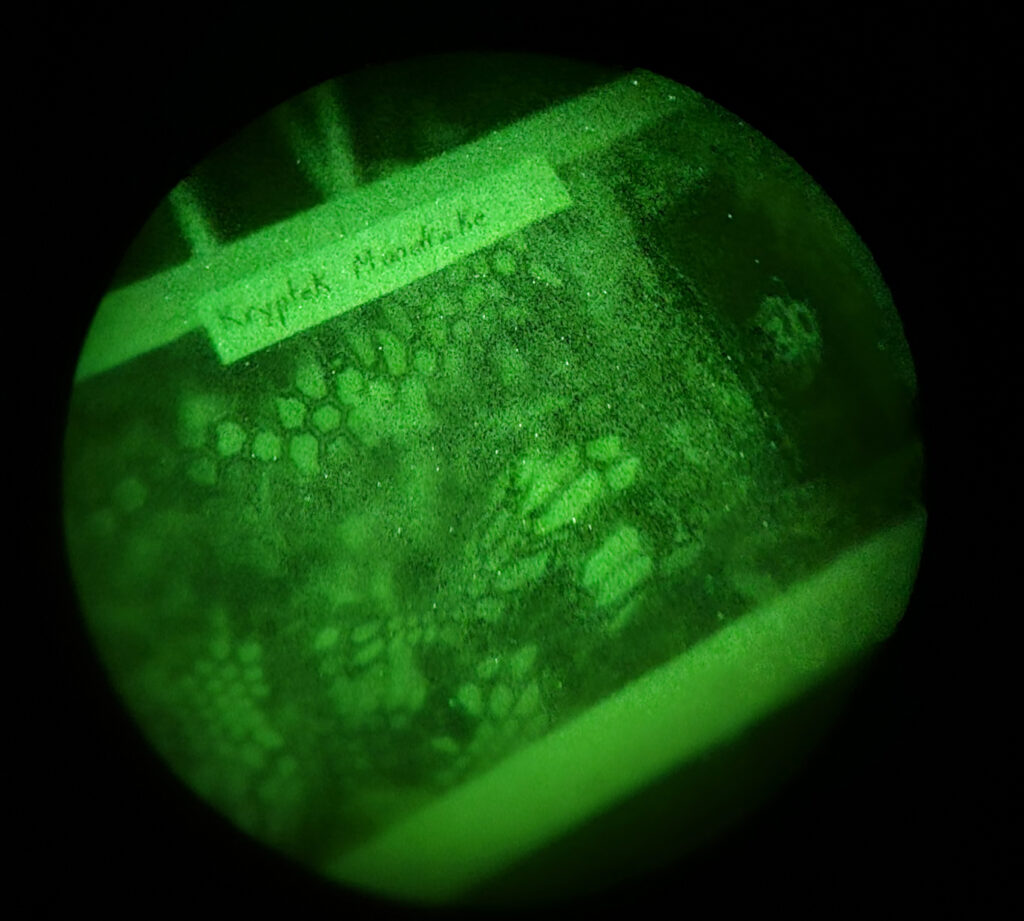
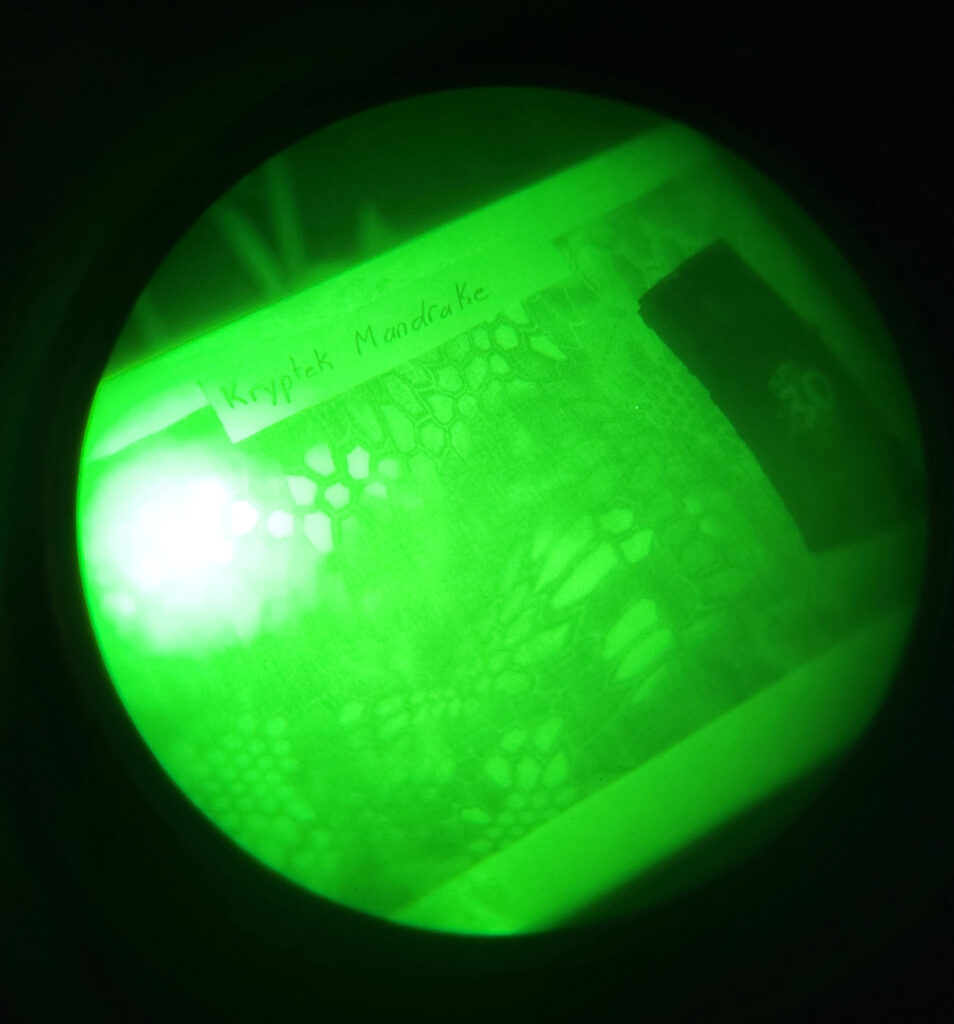
Kryptek RAID
500 Denier CORDURA fabric. Licensed material. Purchased from Rockywoods.
Webbing purchased from Whiskey Two Four. Unsure of the spec.
RAID is quite rare and it is unlikely you will run into it in the “wild”. As far as I know RAID was originally meant as the Law Enforcement pattern of the Kryptek family. It did not appear to catch on. I may have one of the only RAID plate carriers in existence as I made it myself. The fabric results are not great as the pattern is mostly washed out. The webbing results as far as IR goes are pretty good. But honestly I don’t know how well this would work at breaking up your outline.
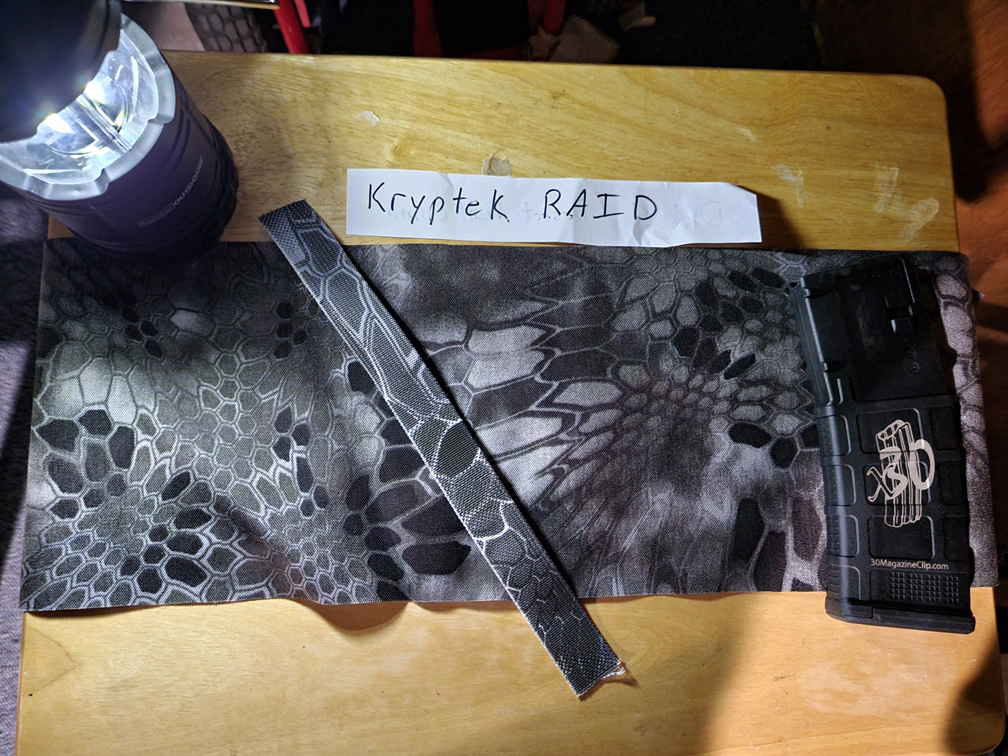
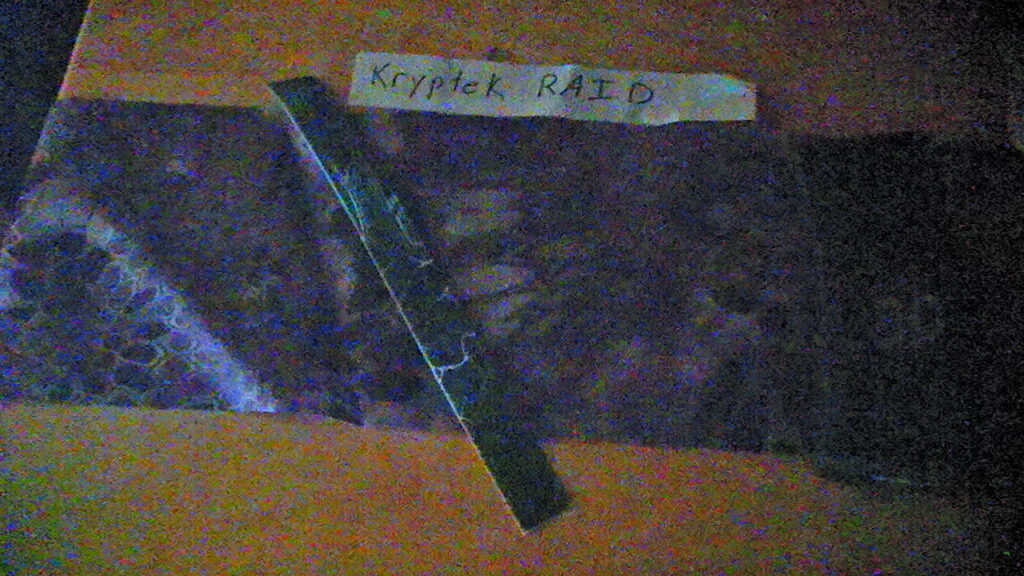
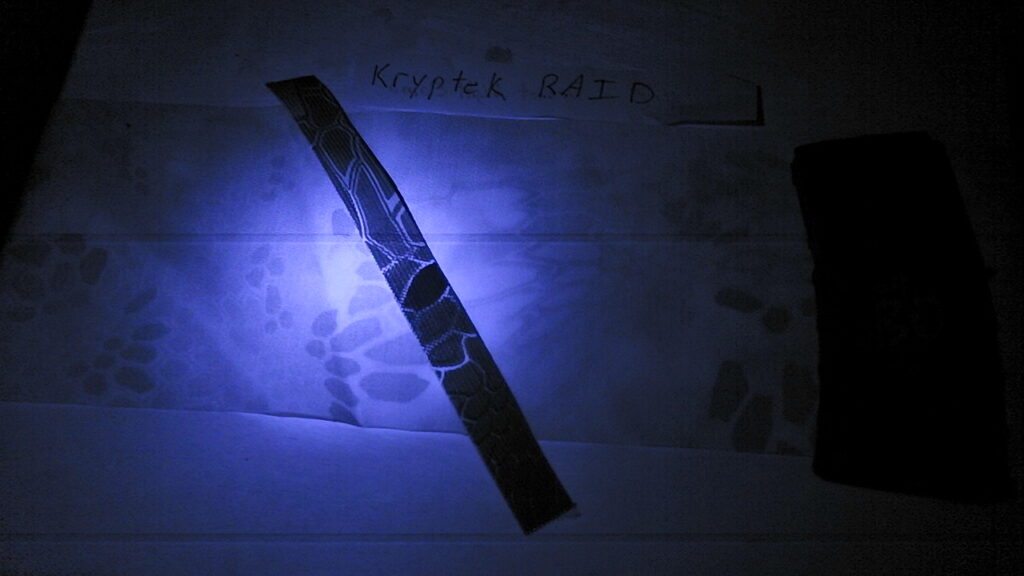
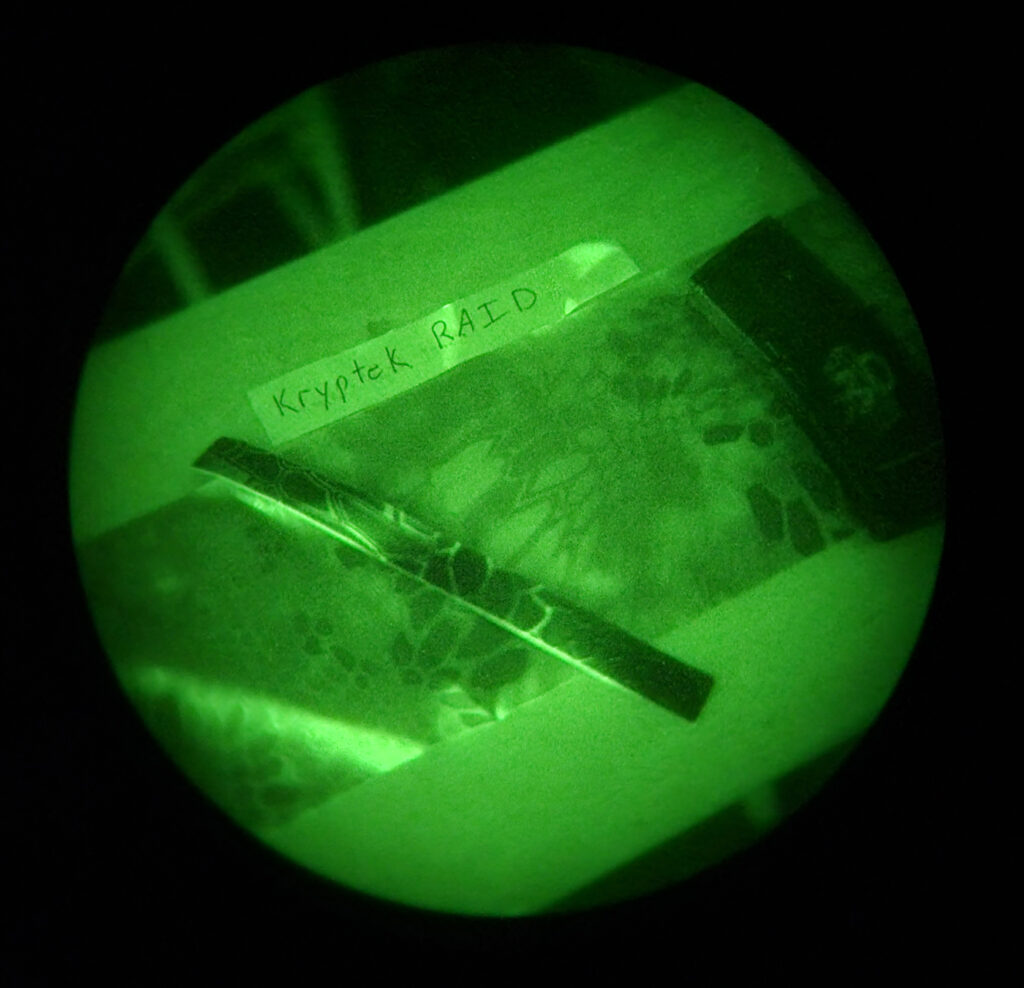
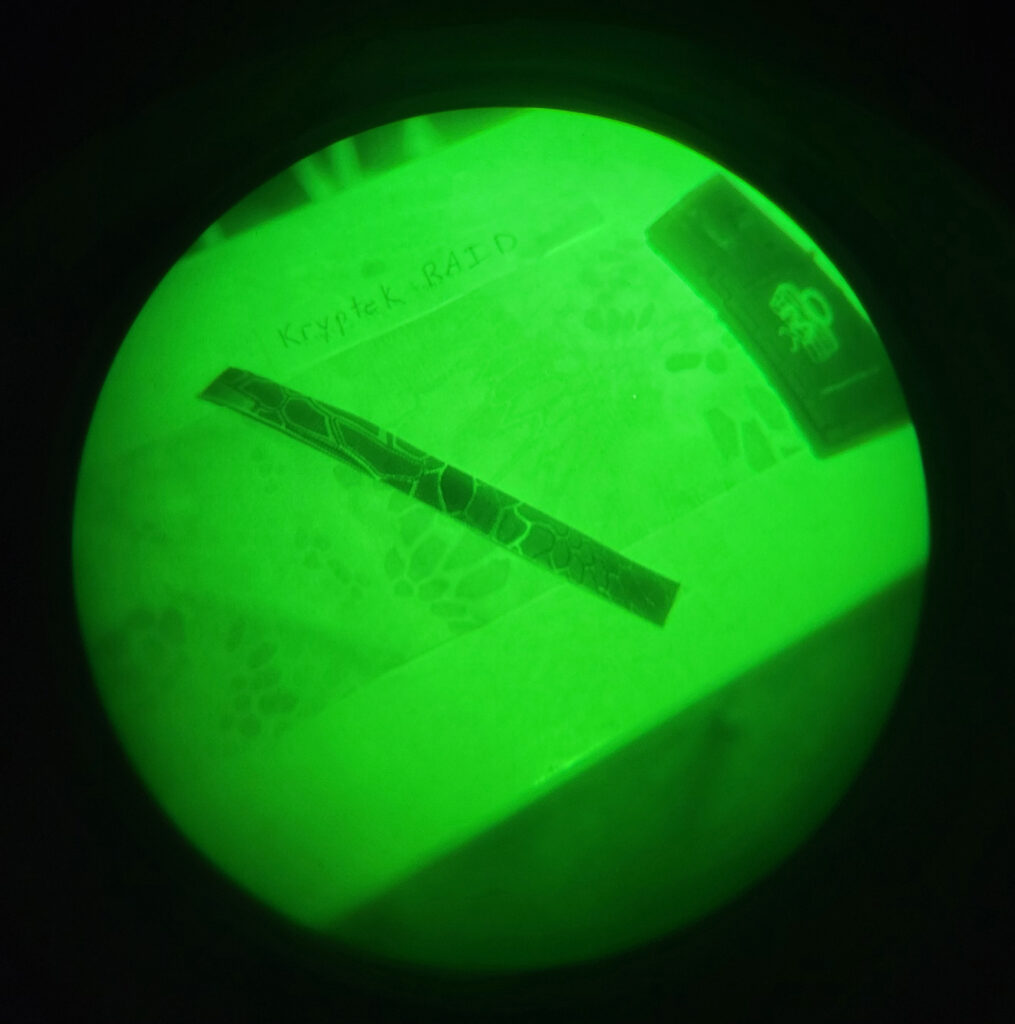
Kryptek Typhon
1000 Denier CORDURA fabric. Licensed material. Purchased from Brookwood Roll Goods.
Webbing MIL-W-17337 from Texcel Industries. Licensed Material.
With Typhon you are going to run into the same IR problem as MultiCam Black. Even though it is NIR material it still can’t help but soak up all that light. Leaving it dark. Now, the pattern is still intact on the fabric and the webbing but your issue is that they react so differently that you are basically making a straight contrasting line among your gear. Which is exactly what you want to avoid.
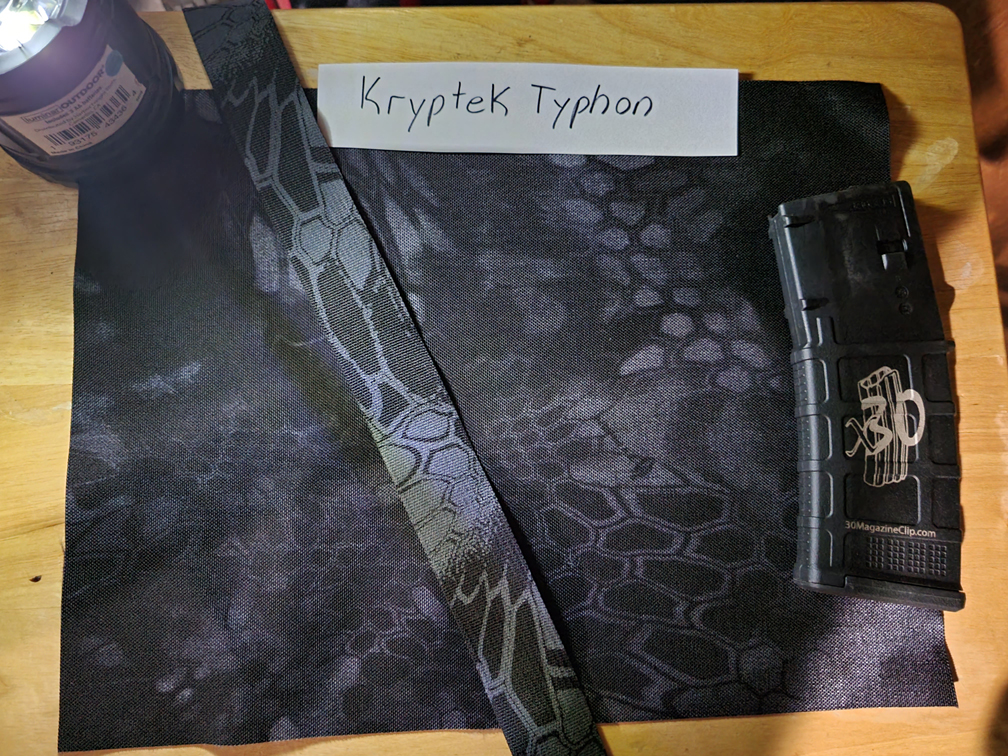
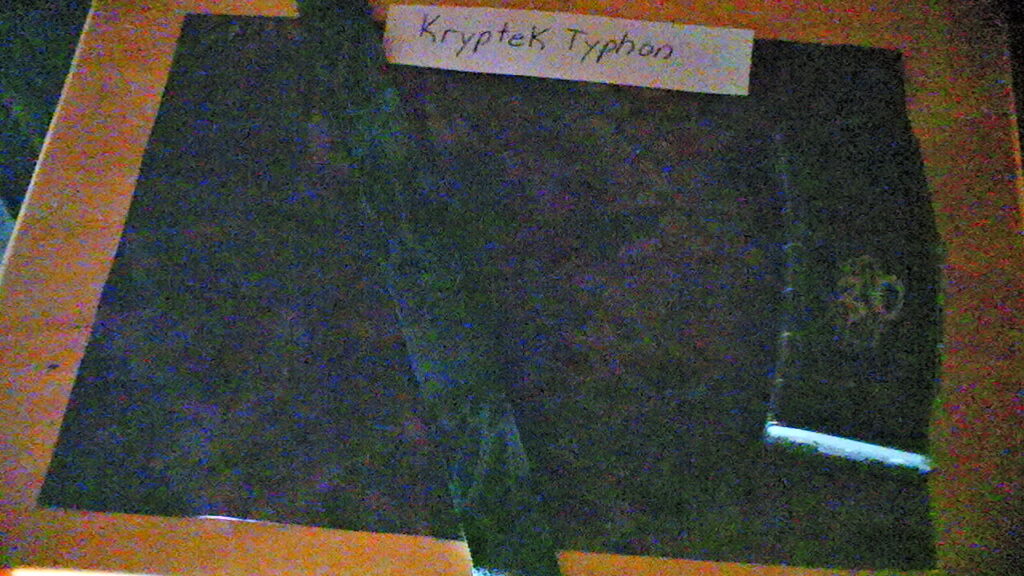
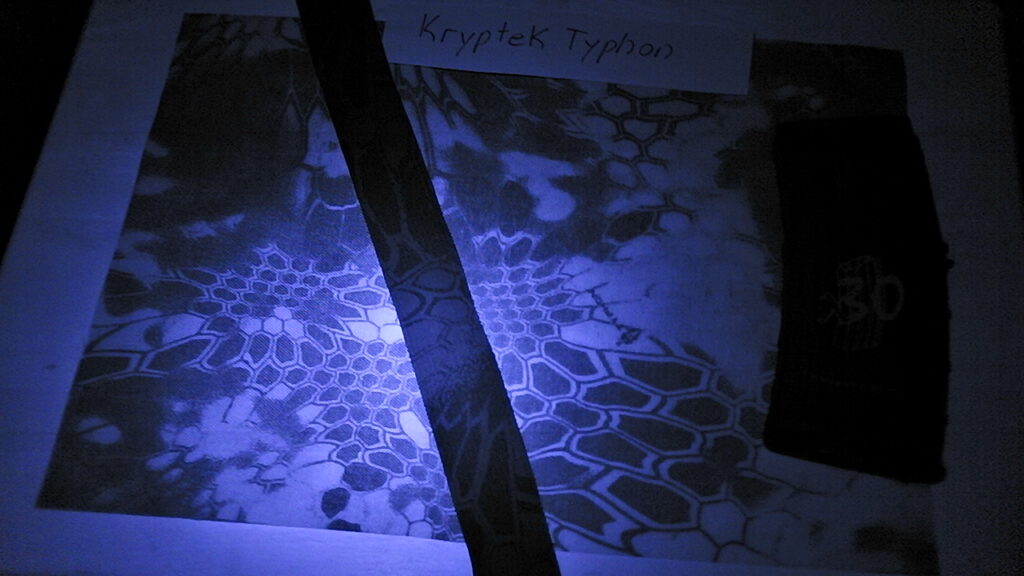
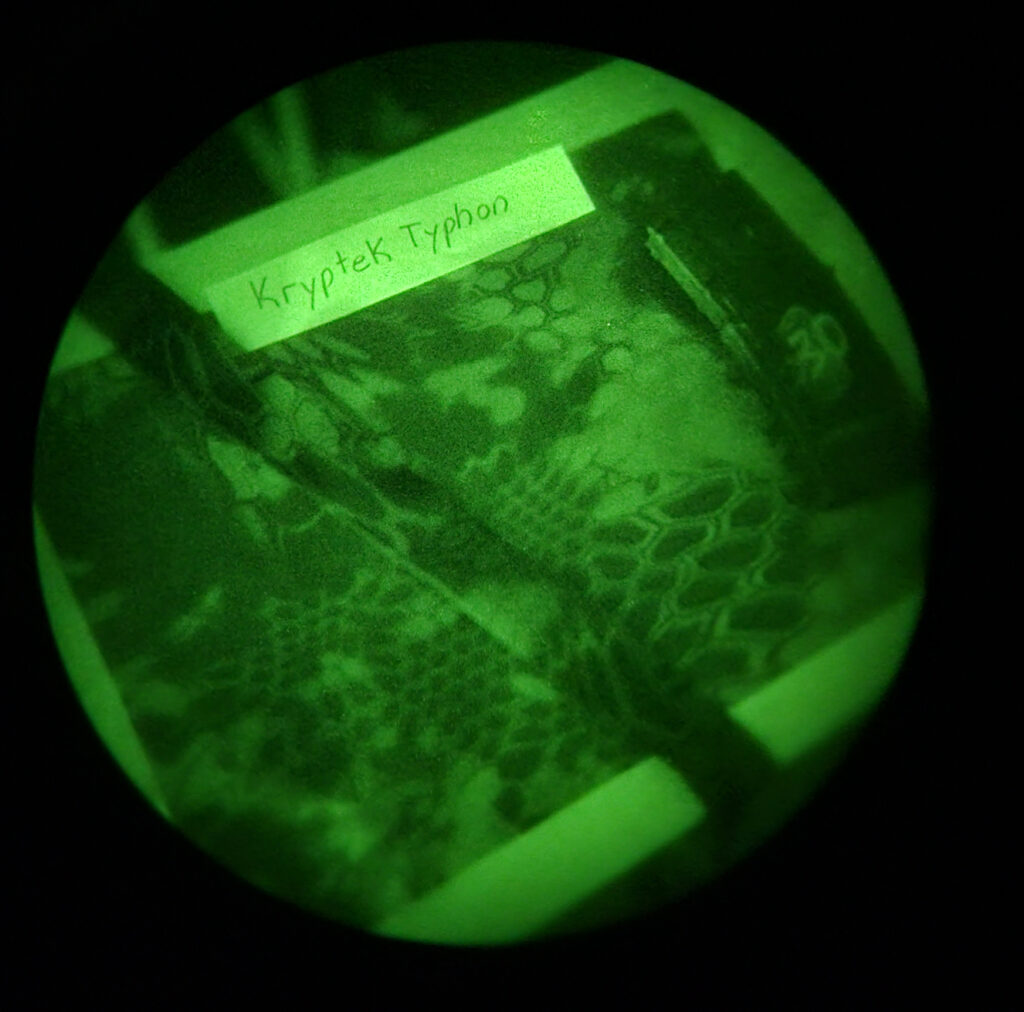
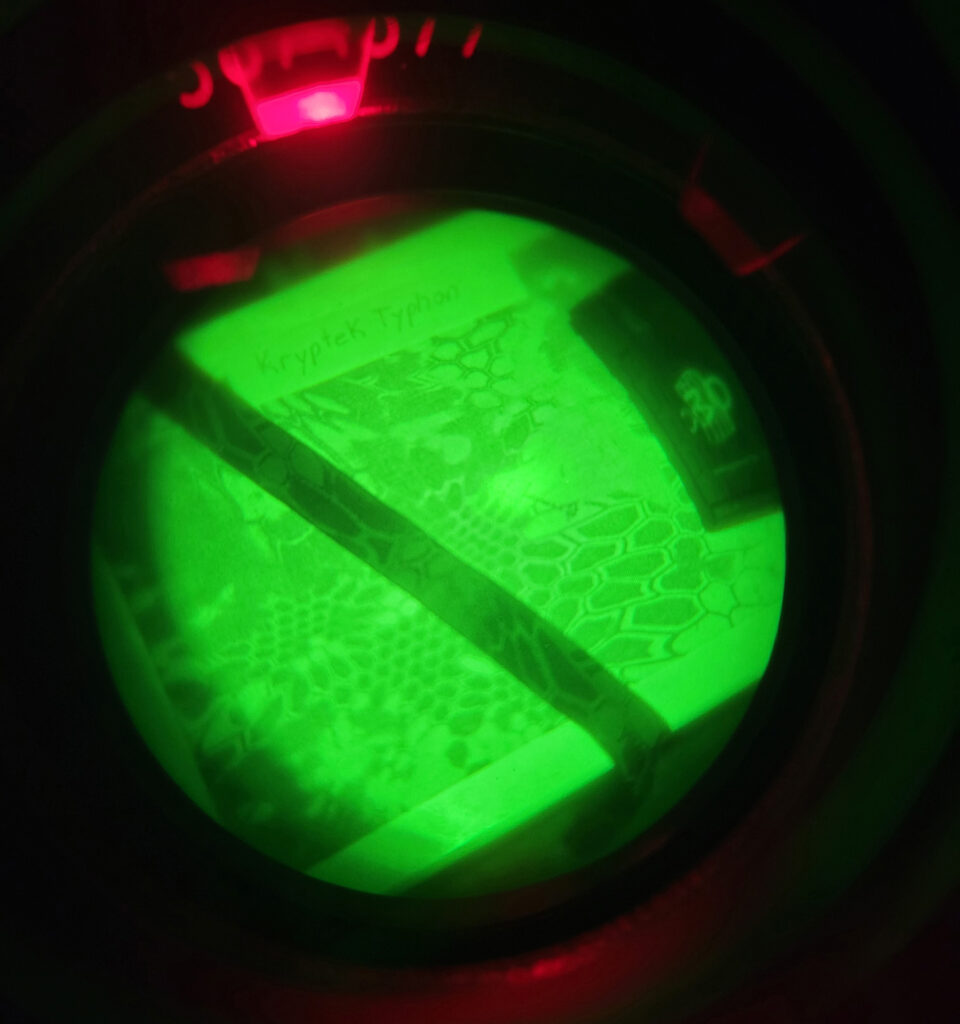
Kryptek Typhon (Dye Sublimation)
1000 Denier CORDURA HP fabric. Licensed material. Purchased from DutchWare via Print on Demand fabric service. See traditional screen printed material above.
Webbing MIL-W-17337 from Texcel Industries. Licensed Material.
While the Typhon pattern looks great via Dye Sublimation it has zero capability to hide when hit with IR light. The pattern completely disappears.
